This afternoon in Antsirabe was practically the only one when we wanted to visit something while it was raining, which for January, as the peak of the rainy season, was not too bad at all. Admittedly, it rained in waves, so when we reached the first workshop we did not need any protection.
Antsirabe, like the towns we were to go through over the following couple of days, is known for its artisans who work very skilfully with different materials. Over time, their workshops have become almost mandatory stops for foreign visitors and there by the rule they first show you how different objects are made using the materials for which the given workshop is known and then you move to the exhibit and sale section where you are expected to buy something.
We first went to a workshop where they very skilfully use waste such as aluminium cans, unused medicinal plastic infusion tubes, wires, springs, etc., in order to make miniature objects such as bicycles, rickshaws, cars and so on. It was truly impressive to watch as one young man made a proper small bicycle with many details right on the spot in front of our eyes, although it was a little boring as well.
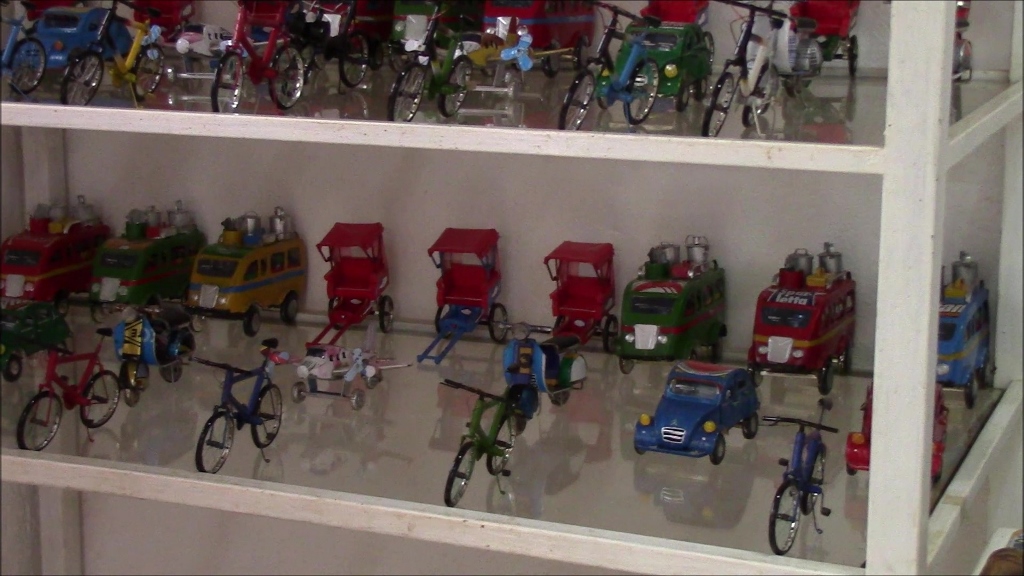 Exhibited objects made of waste
Exhibited objects made of waste
When we got out, it was really pouring (perhaps it was a punishment for not buying anything in the shop), but we still drove over to another workshop in which they use zebus’ horns to make different objects – some serve only as decoration, while others have practical application.
However, let me say something about zebus. This is a kind of domestic cattle originating from south Asia and they can be recognised quite easily because they have a characteristic fatty hump on their shoulders. Since zebus are accustomed to withstand high temperatures, they are broadly used throughout the topical areas world over. They are used as draught animals, including farm work, and as dairy and beef cattle. Also, it seems to me that when it comes to offering sacrifices, the zebu is the favourite animal, which would later during our journey be corroborated.
In addition to all of this, the zebus’ horns can also be processed and thus different objects can be made out of them. When the two of us came to the workshop, it rained so much that we just ran into the exhibit and sale section, completely forgetting to go to the section where they would show us how the horns are processed. The hosts were not too preoccupied about this, since after all the goal of the whole thing is that the visitors end up in the shop and buy something.
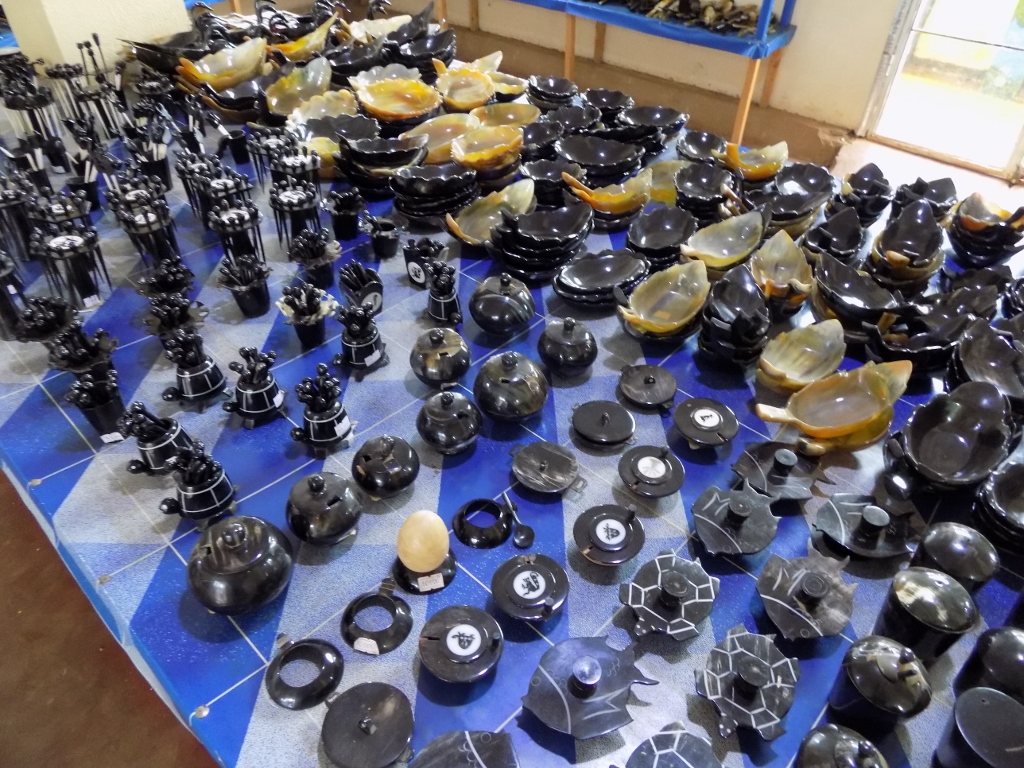 Part of the objects made out of zebus’ horns
Part of the objects made out of zebus’ horns
Here Sneža and I did buy a few items and then since the gods of shopping were satisfied, the rain had stopped significantly by the time we got out of the workshop.
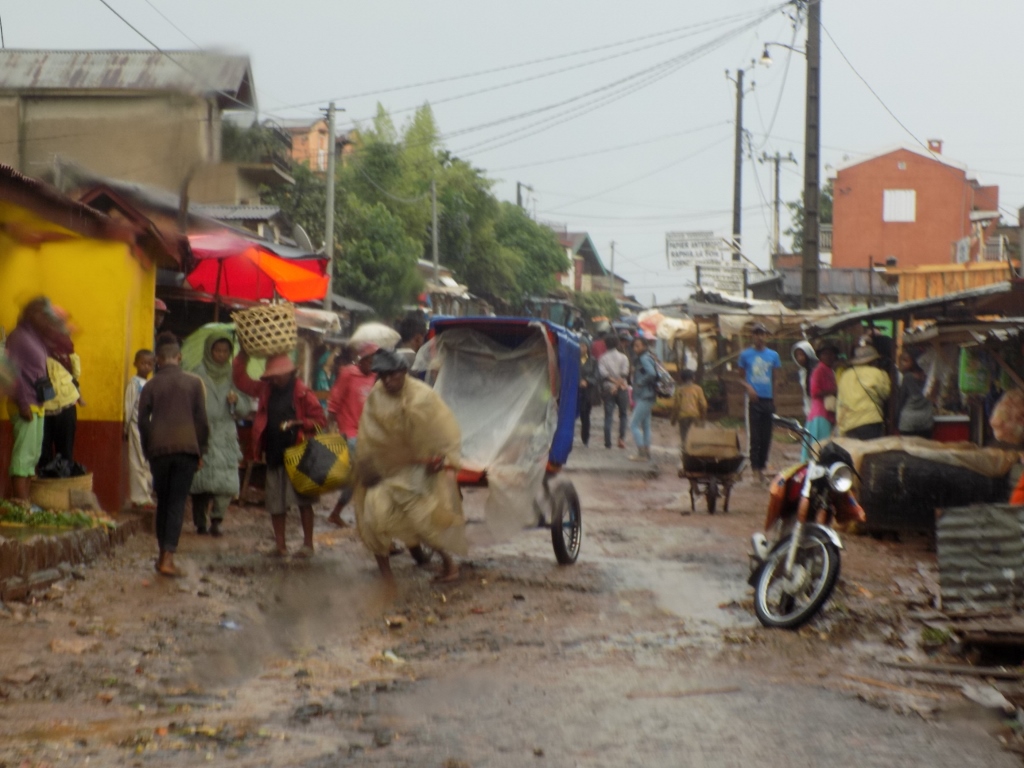 Market section of a street in Antsirabe on a rainy day (the photo is blurred, but illustrative)
Market section of a street in Antsirabe on a rainy day (the photo is blurred, but illustrative)
We spent the rest of the day at the bed and breakfast or in its vicinity when we went out to have dinner. Since it was cloudy all the time, we were not keen on wondering aimlessly around the city as there was a reasonable danger of getting soaked.
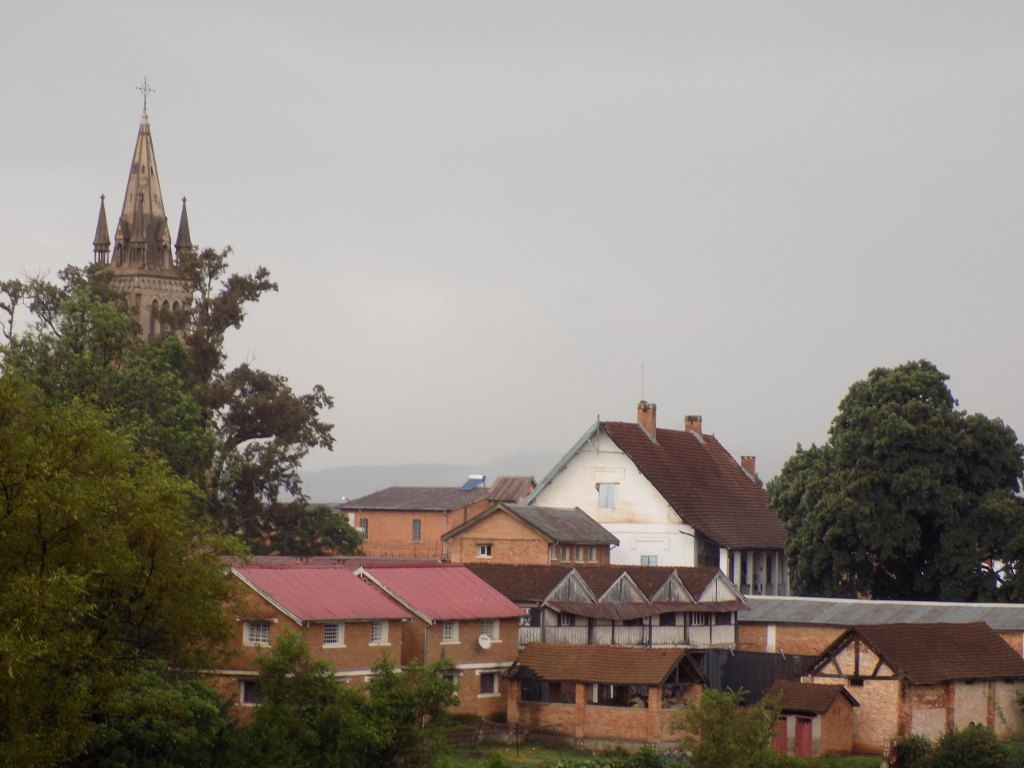 View at the surroundings of our B&B
View at the surroundings of our B&B
Already the next morning we were greeted by beautiful blue sky and we went first by car for a brief additional sightseeing of Antsirabe before continuing with our journey around Madagascar. We passed again along the Grande Avenue, heading towards the railway station building, but along the way we also saw the Fahaleovantena Tribes Monument. There are 18 tribes or ethnic groups on Madagascar and although the Merina tribe which lives in the highlands is the most numerous, this ethnic diversity is frequently emphasised. It was the rulers from the Merina tribe who unified Madagascar at the beginning of the 19th century following numerous wars and conflicts.
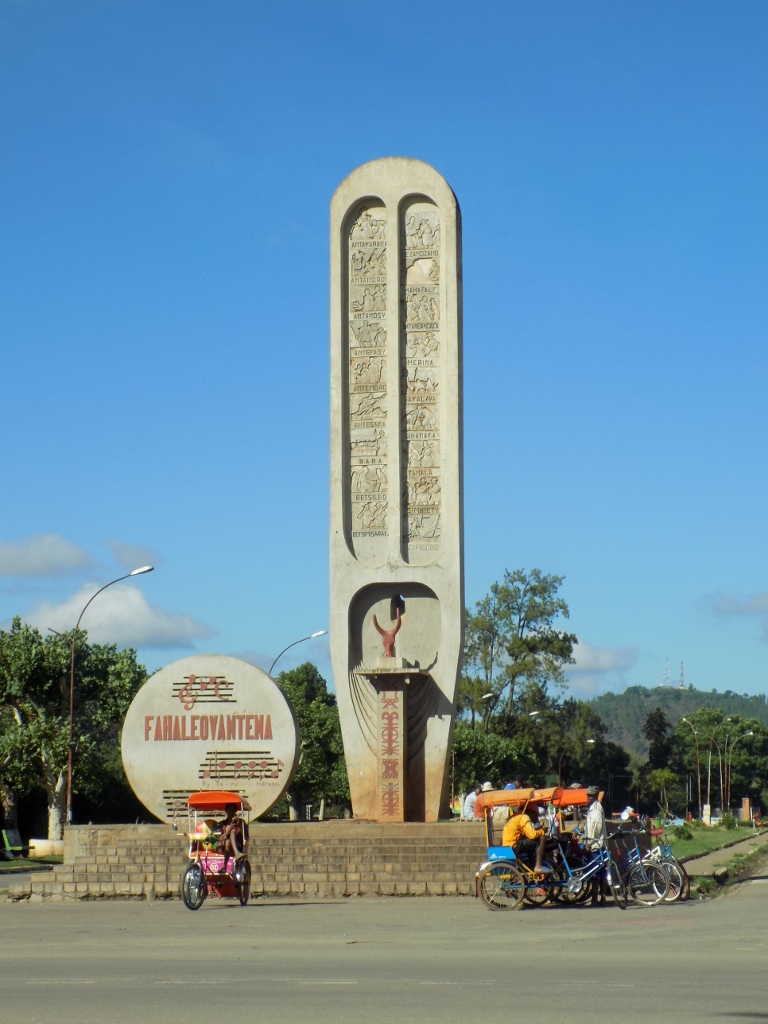 Fahaleovantena Tribes Monument
Fahaleovantena Tribes Monument
Then we came to the square in front of the railway station from which the Grande Avenue starts and there were several parked pulled rickshaws or pousse-pousses which Antsirabe is known for and which were waiting for their customers. We were not particularly interested in going for a ride, but that does not mean we were not ready to have photos taken.
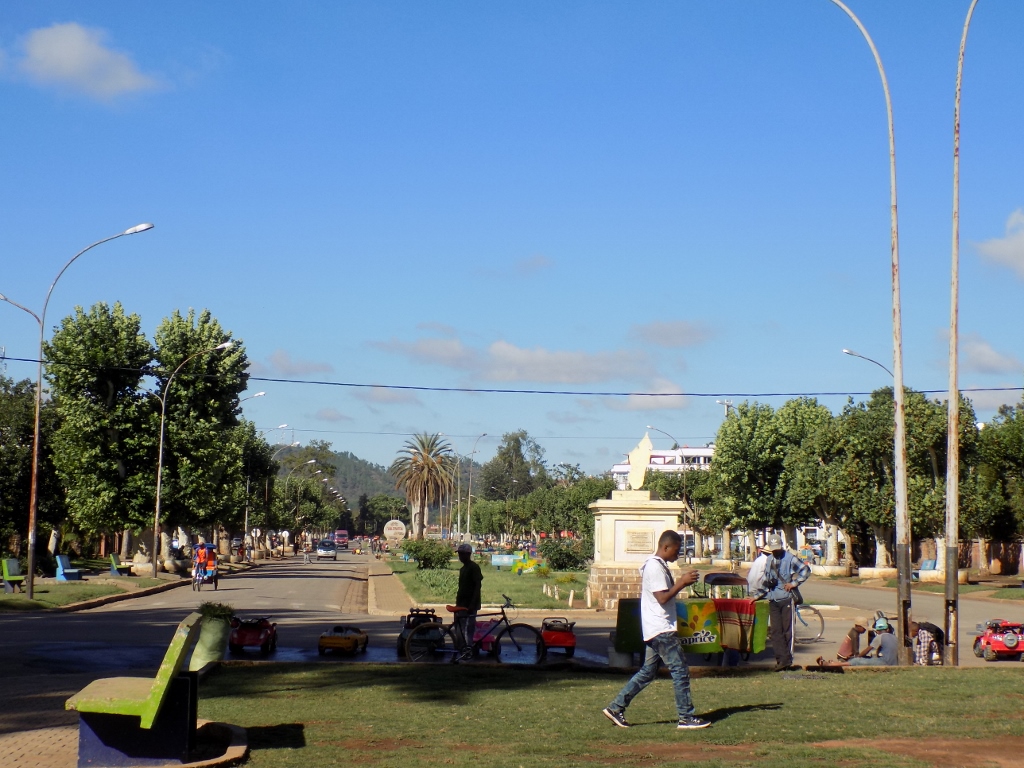 Grande Avenue
Grande Avenue
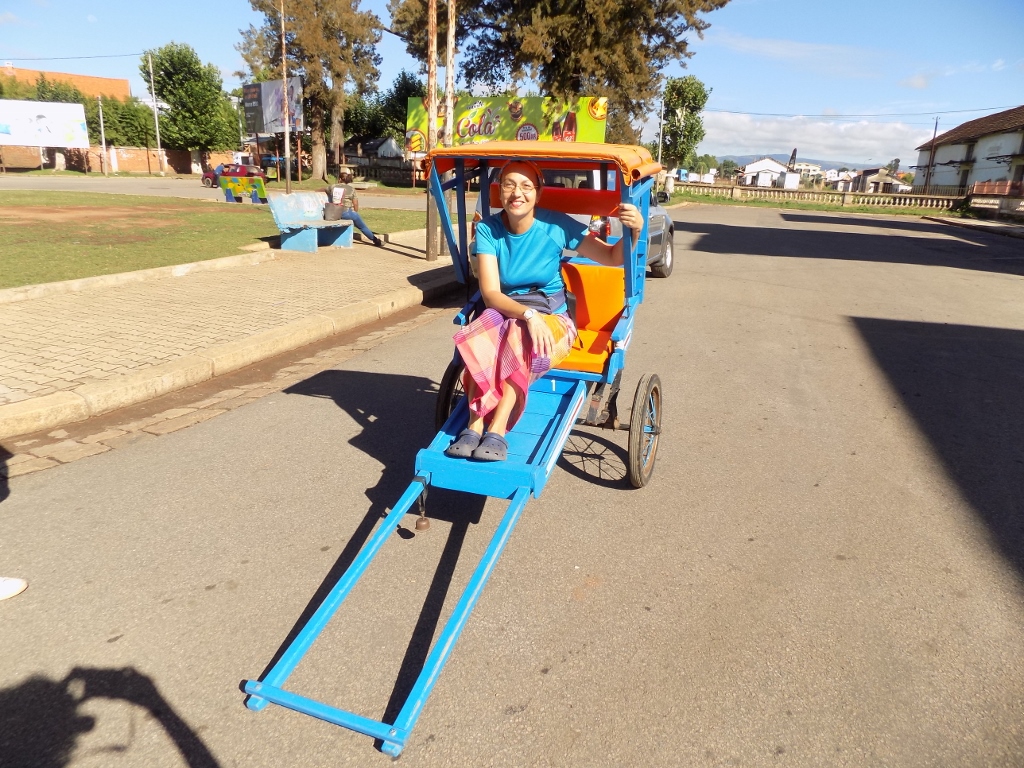 Me in a pousse-pousse
Me in a pousse-pousse
After this we simply returned by car along the same wide street, since on the opposite end in relation to the railway station there is a large and impressive Hotel des Thermes which, as its name says, is a hotel in which you can enjoy different spa treatments using salty thermal waters which Antsirabe has been named after.
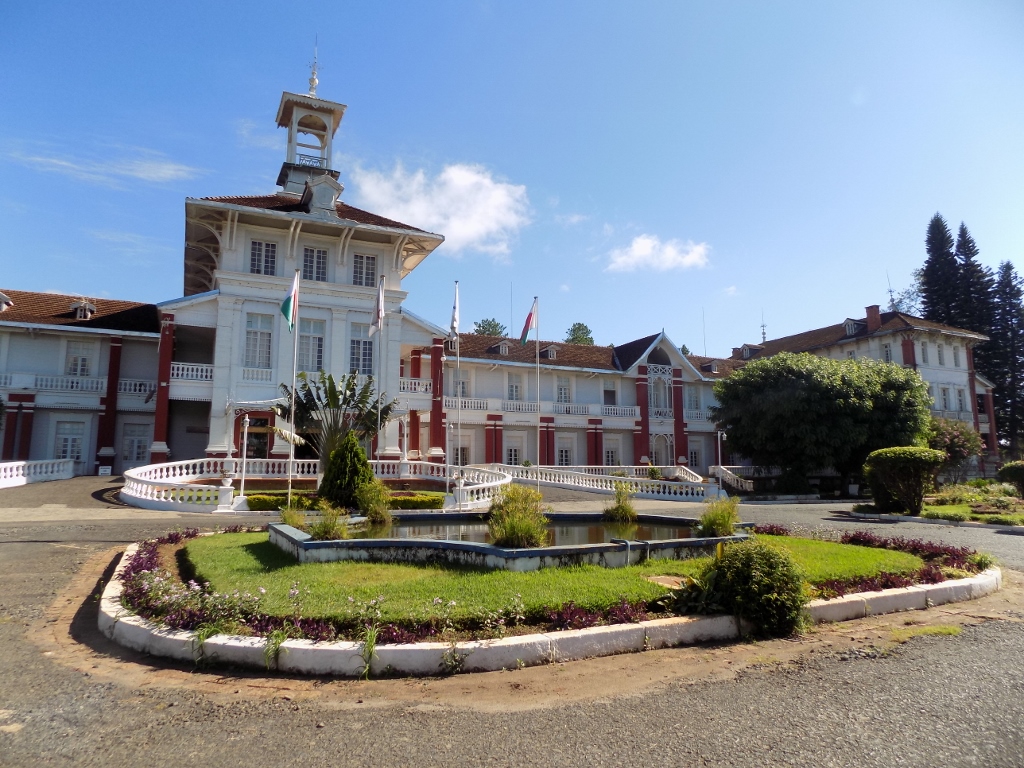 Hotel des Thermes
Hotel des Thermes
We also stopped by the Cathedral in Antsirabe, but at the time of our visit it was closed.
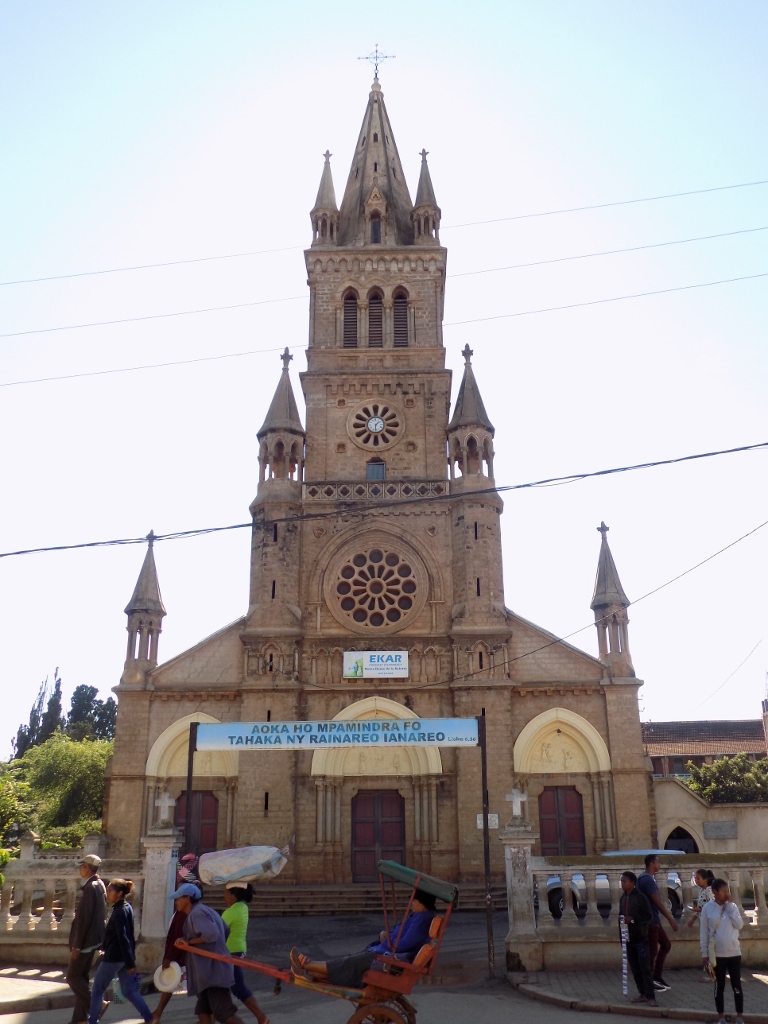 Cathedral in Antsirabe
Cathedral in Antsirabe
So, we went to yet another workshop and this one was dealing with semi-precious stones. The quantity, as well as the quality of the crystals they had was truly incredible. One part of the yard was completely covered with different crystals and they had tortoises walk around, on top of which they also piled up crystals in one section of the yard.
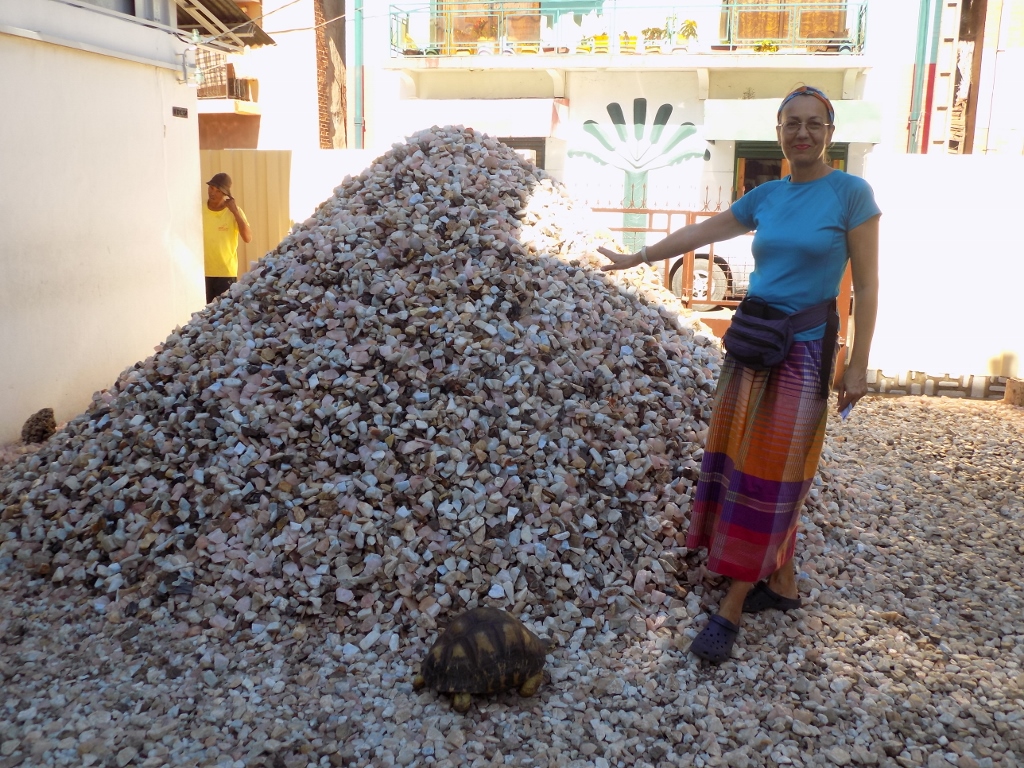 The crystals were plentiful here
The crystals were plentiful here
We completed our stay in Antsirabe by going to the local market. When travelling, I generally love to visit green markets and this one here was quite big and had sections dedicated to food, clothes and every-day objects, as well as a section intended for tourists.
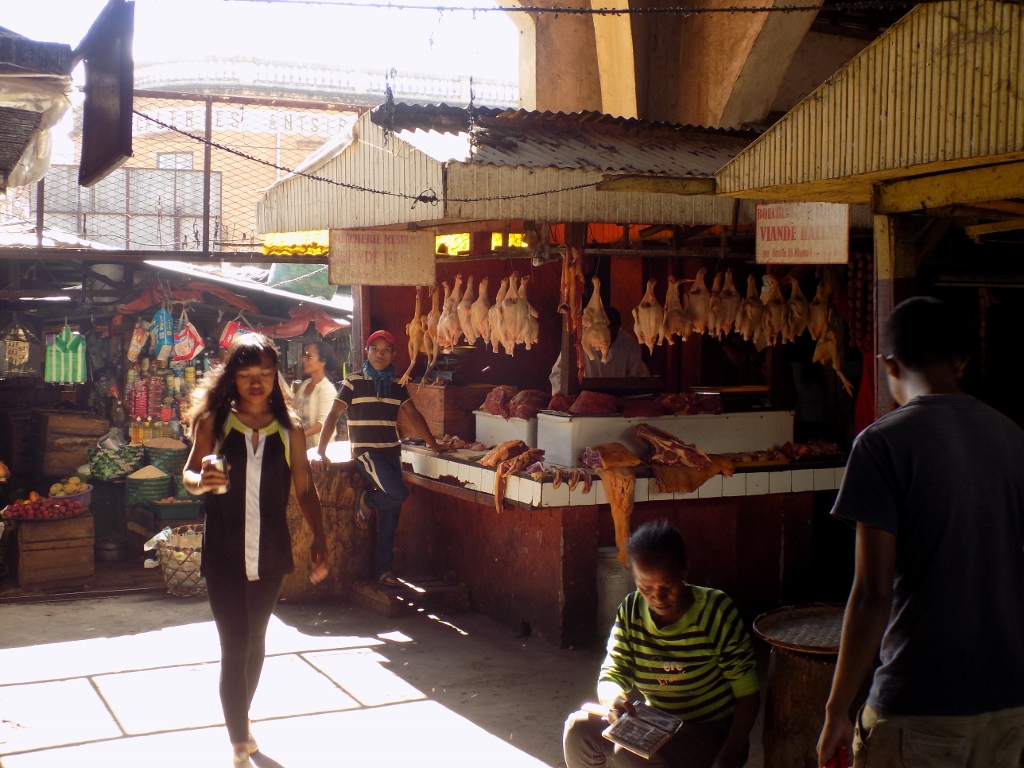 Market in Antsirabe
Market in Antsirabe
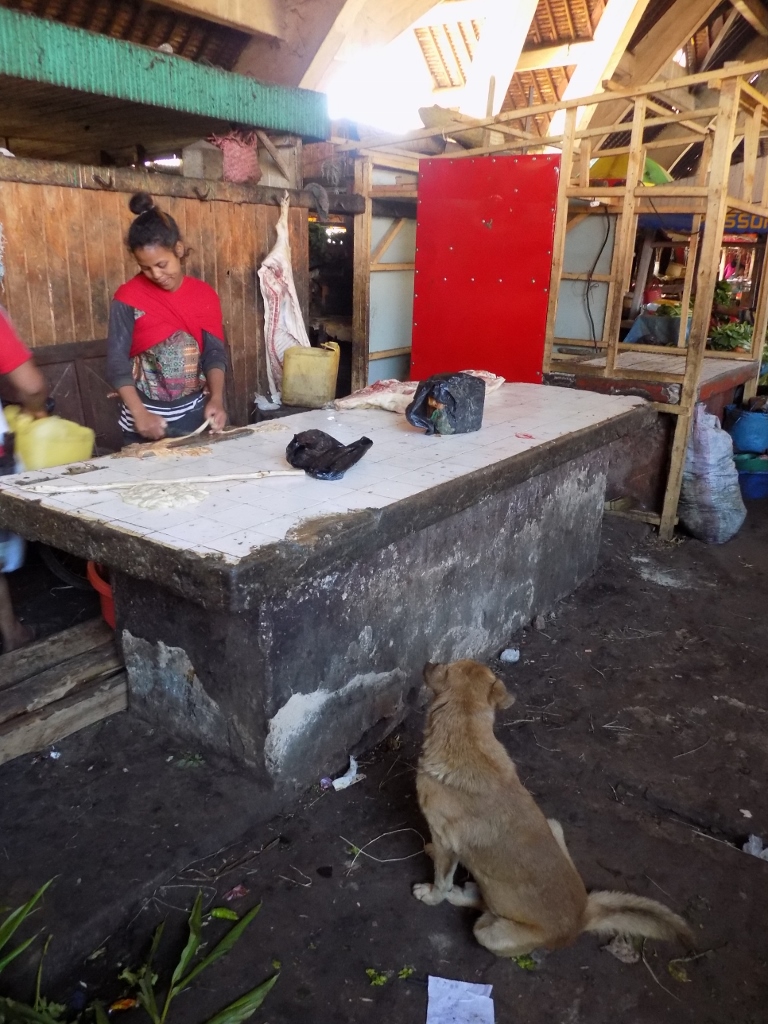 Market in Antsirabe – will I be getting some of these guts?
Market in Antsirabe – will I be getting some of these guts?
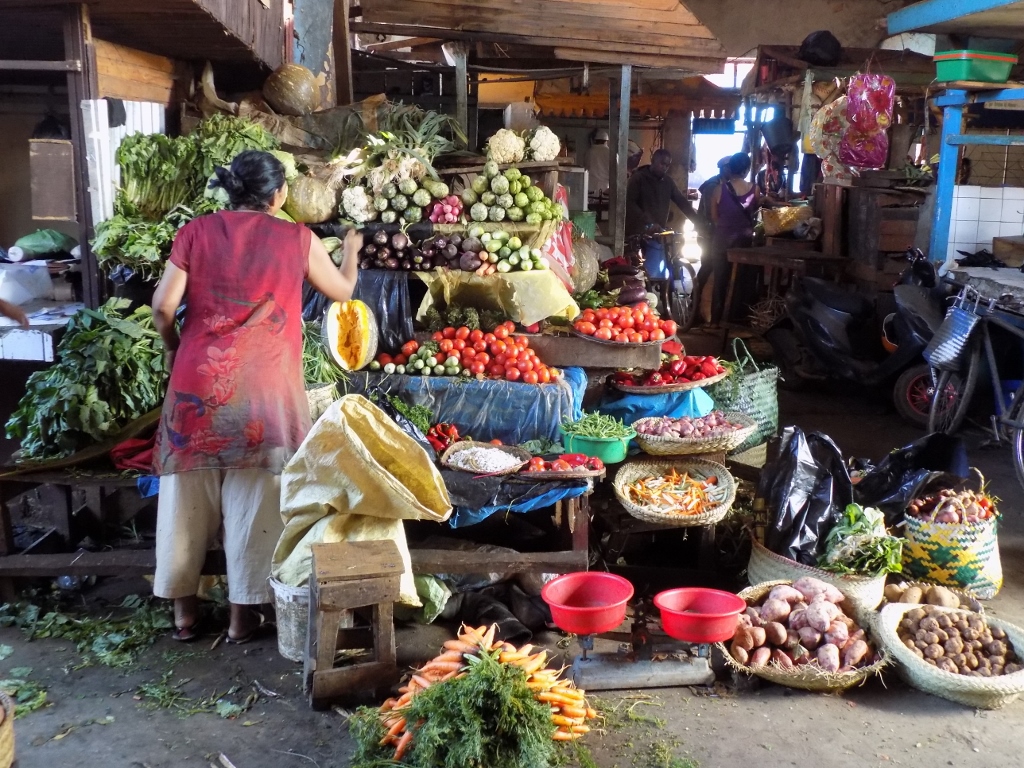 Market in Antsirabe
Market in Antsirabe
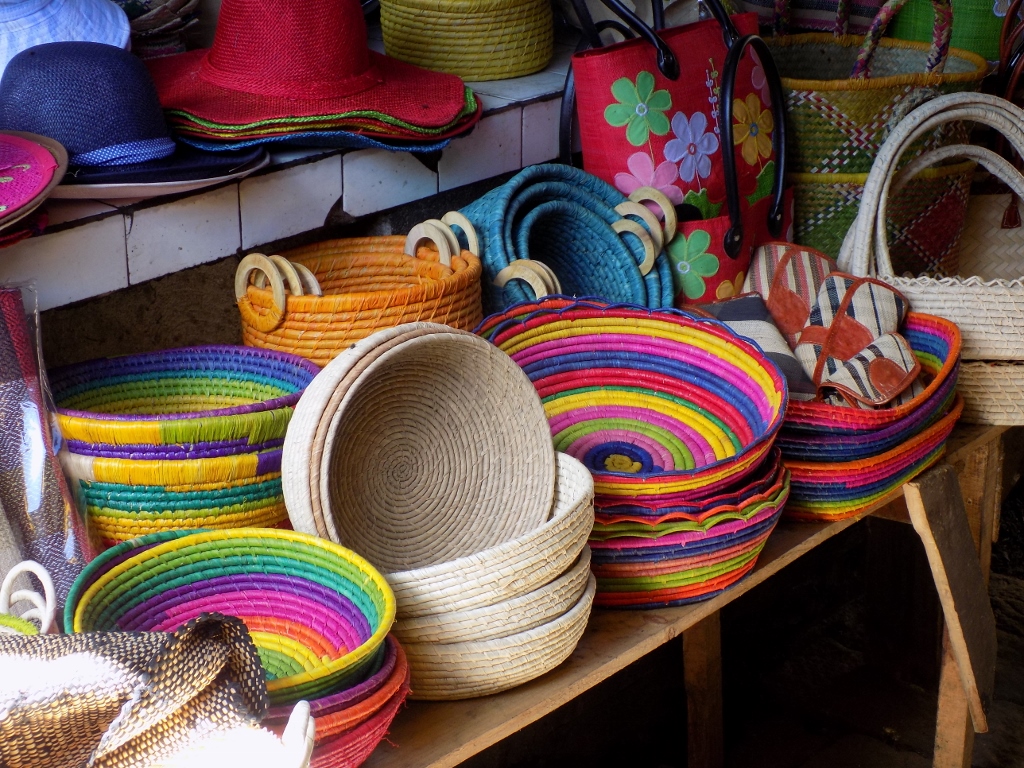 Market in Antsirabe
Market in Antsirabe
Following our visit to the market we headed south, driving along the National Road no. 7 (RN7) and our next stop was town Ambositra. Still, in the meantime, I again enjoyed the beauties of Madagascar and different sights that I could see along the road. To start with, here is a map that shows the route we covered by car over the next six days, after which come several photos I took during this drive.
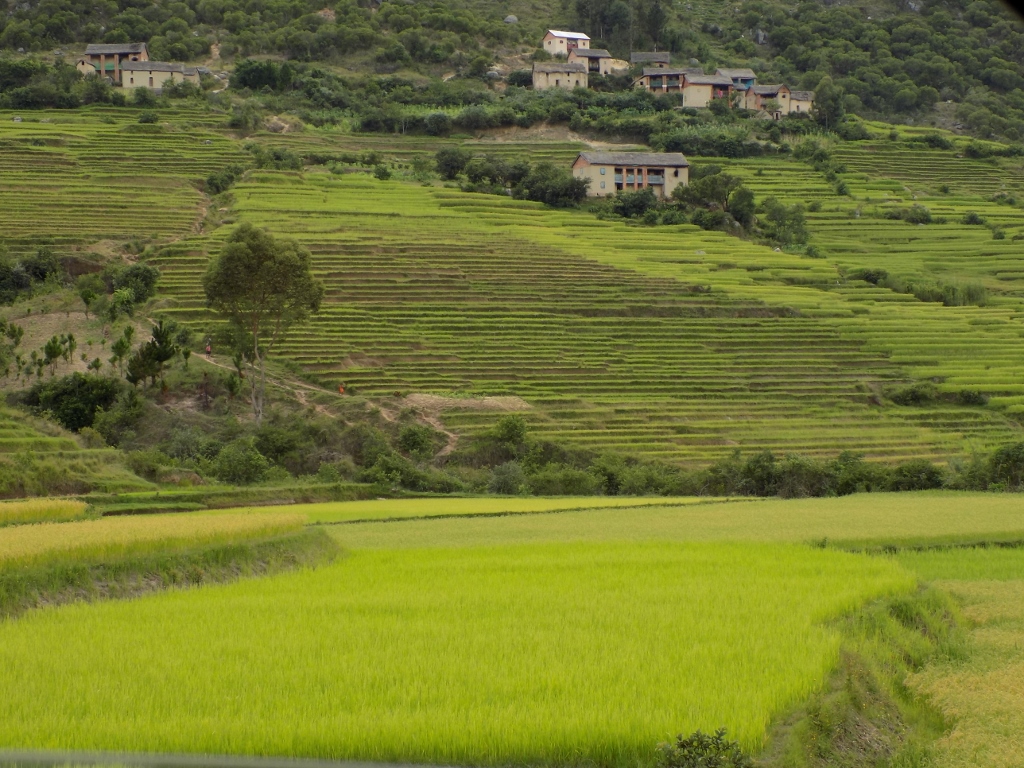 On the road between Antsirabe and Ambositra
On the road between Antsirabe and Ambositra
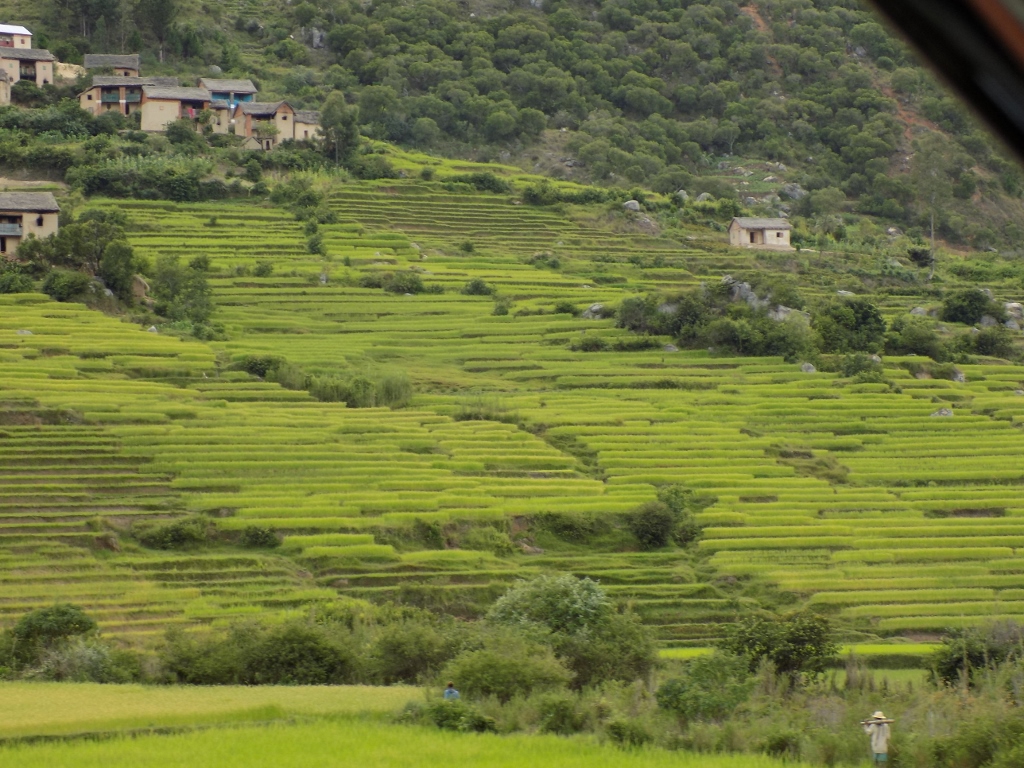 Fantastic agricultural terraces
Fantastic agricultural terraces
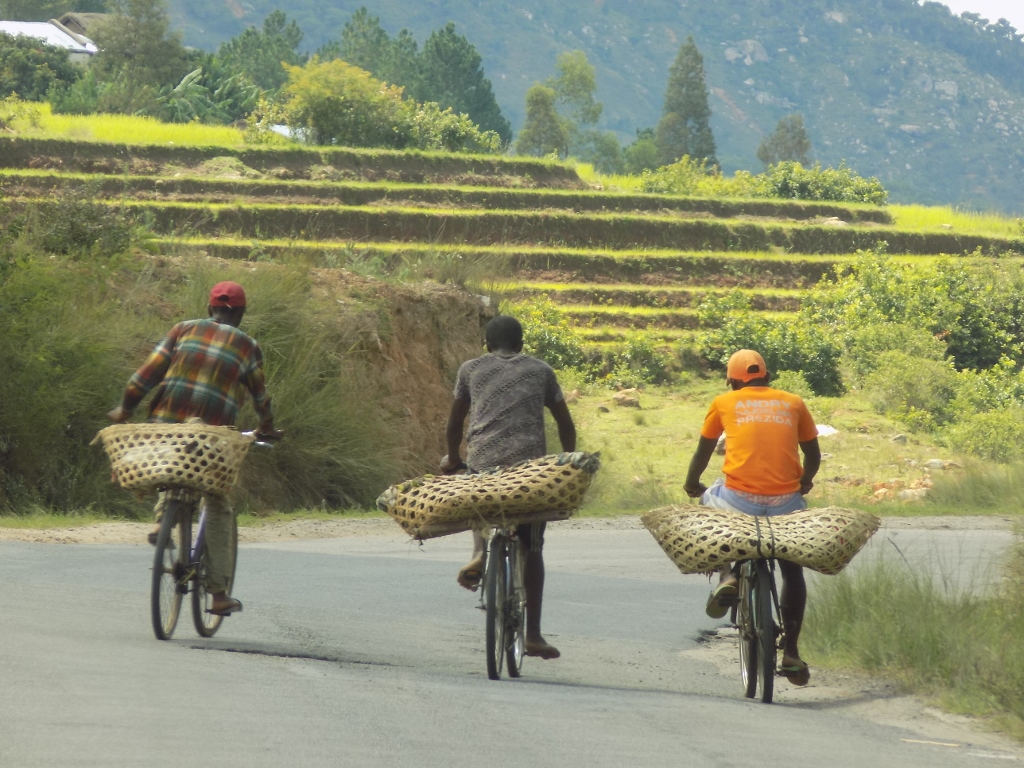 It’s easier to ride a bicycle in company
It’s easier to ride a bicycle in company
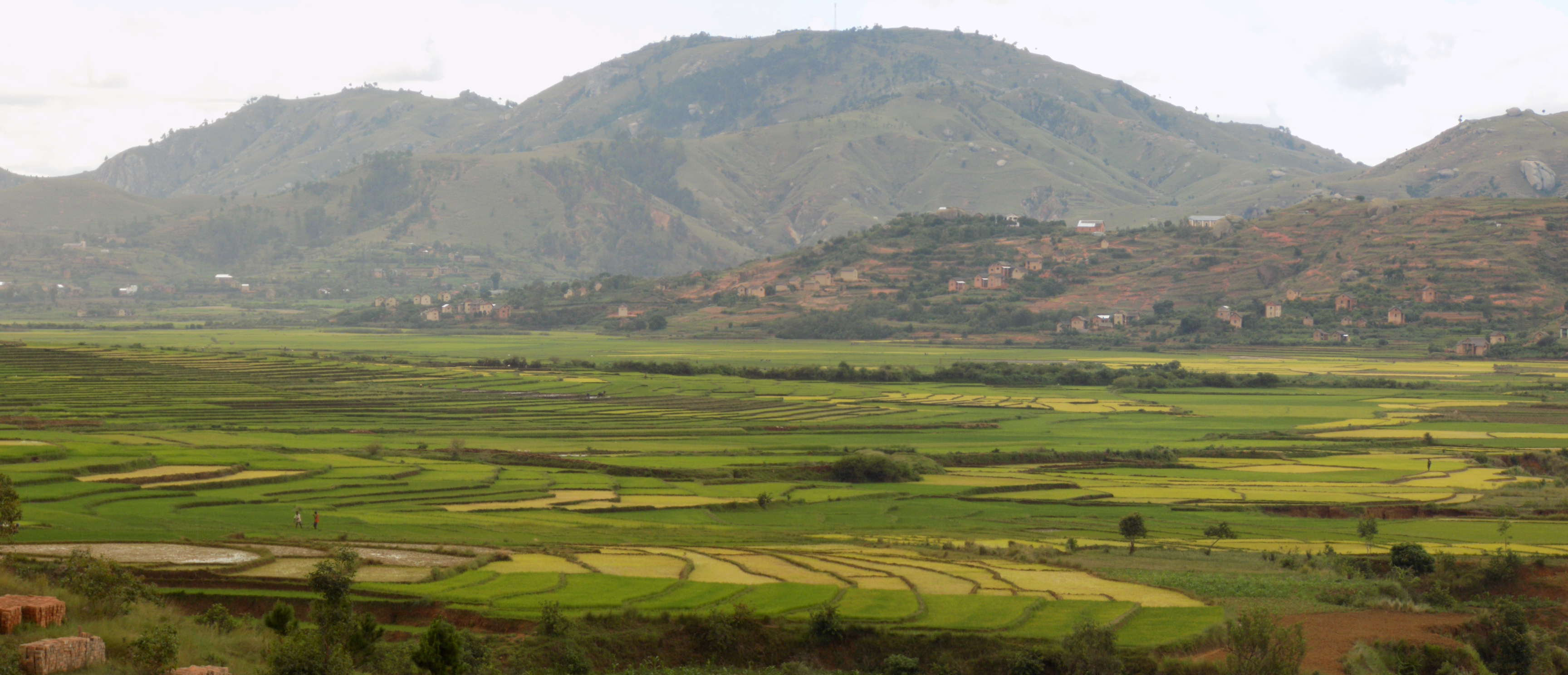
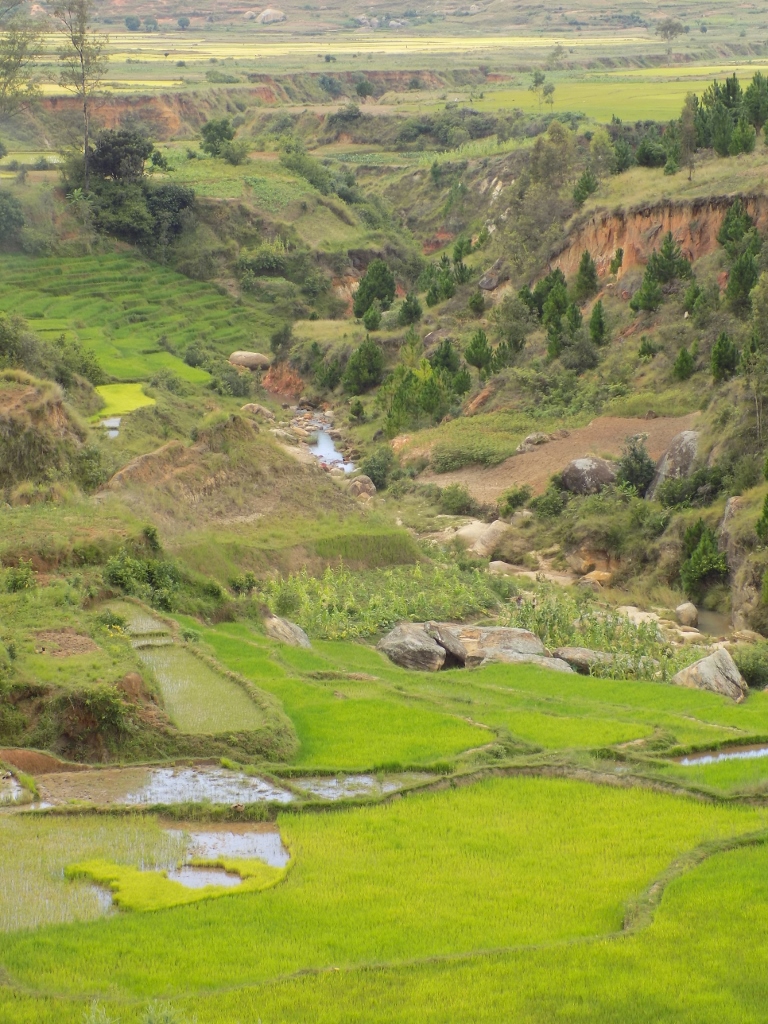 On the road between Antsirabe and Ambositra
On the road between Antsirabe and Ambositra
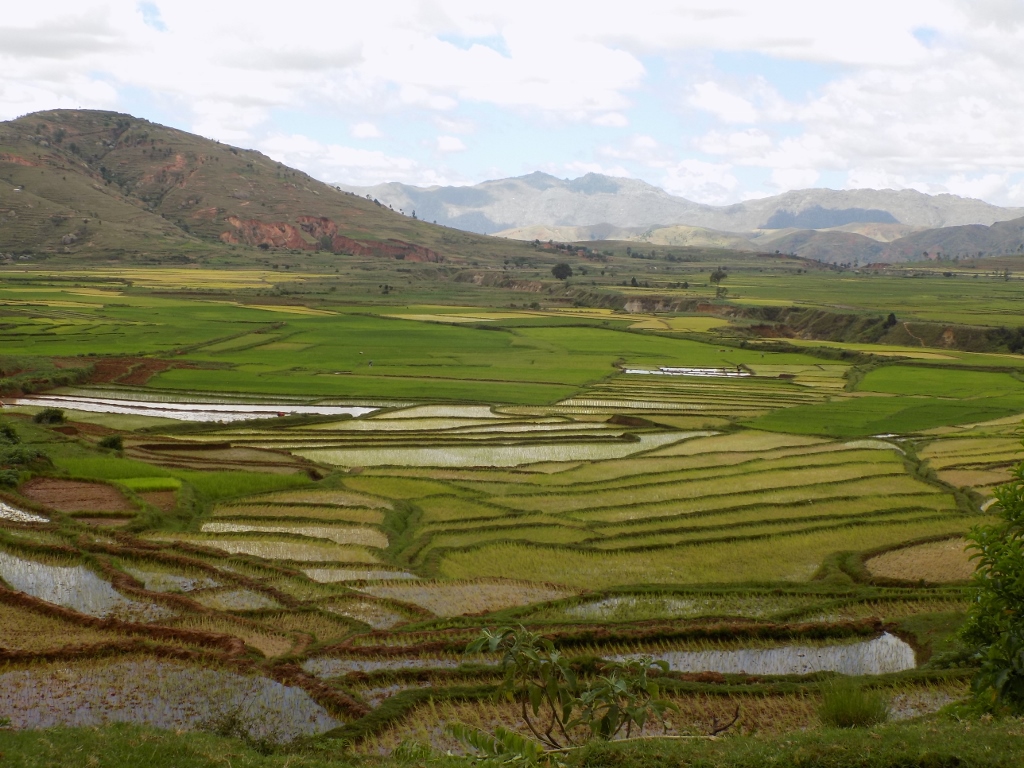 On the road between Antsirabe and Ambositra
On the road between Antsirabe and Ambositra
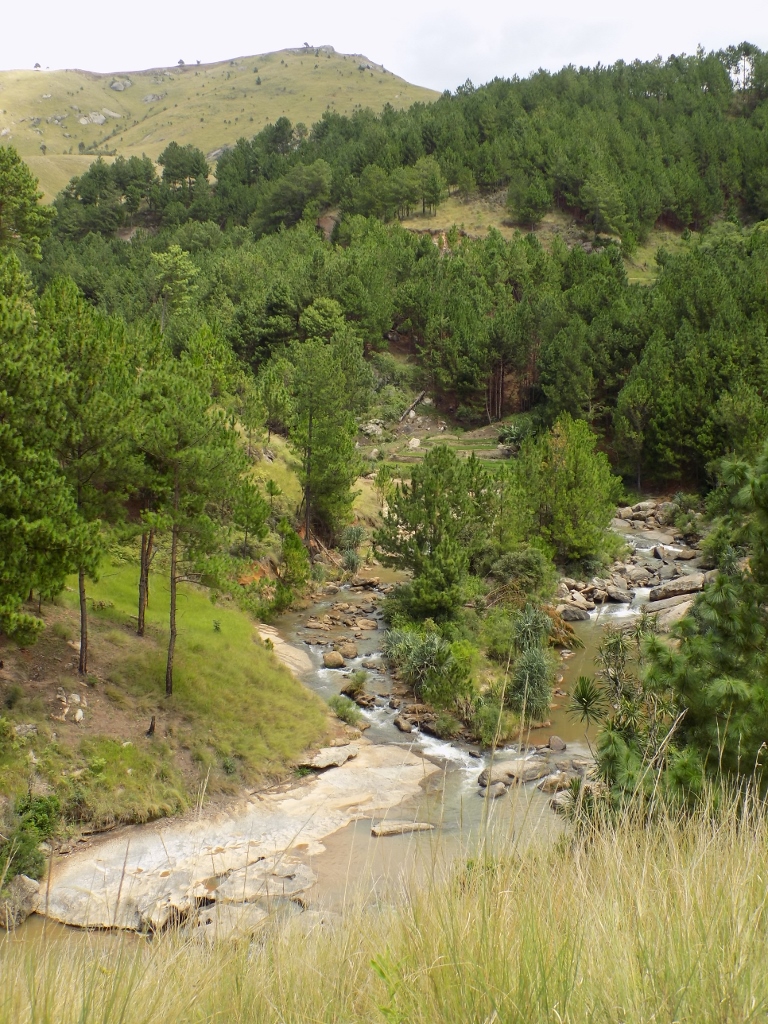 In one section there were a lot of evergreen trees
In one section there were a lot of evergreen trees
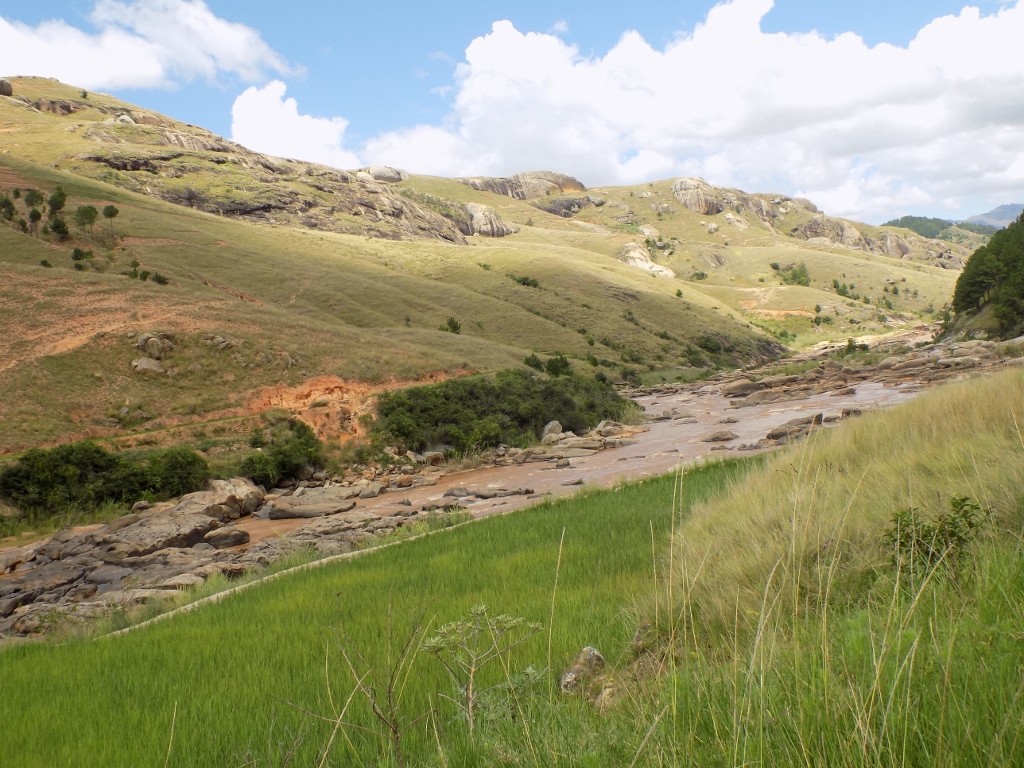 On the road between Antsirabe and Ambositra
On the road between Antsirabe and Ambositra
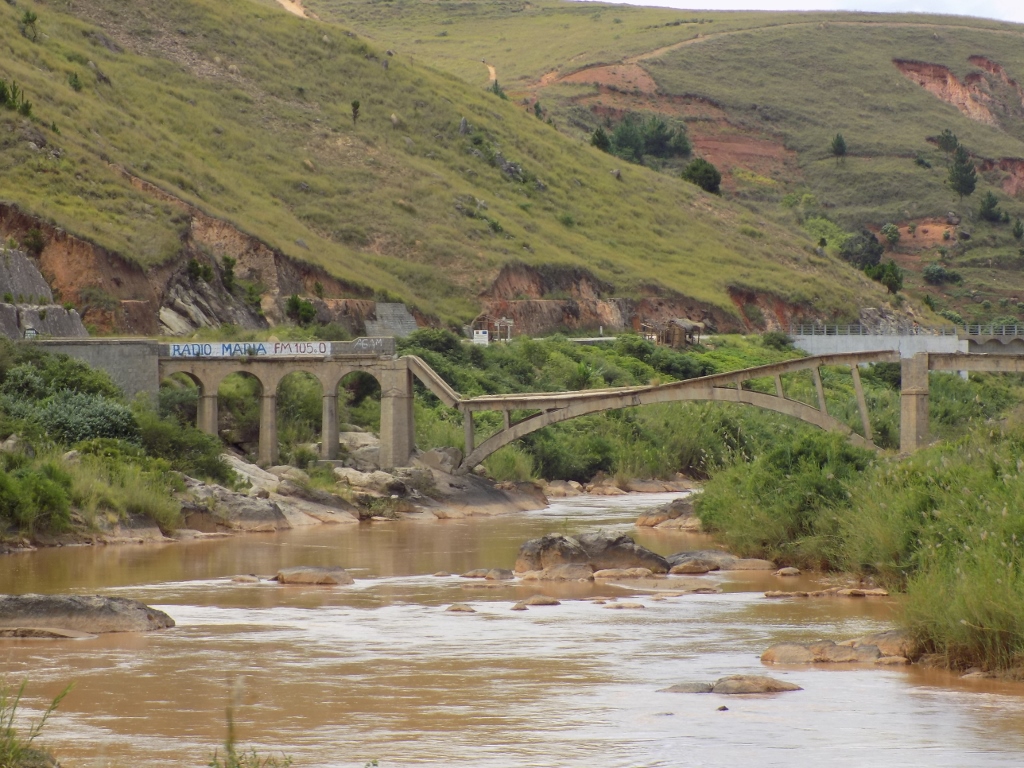 This bridge collapsed at some point, so they built a new one (can be seen in the background)
This bridge collapsed at some point, so they built a new one (can be seen in the background)
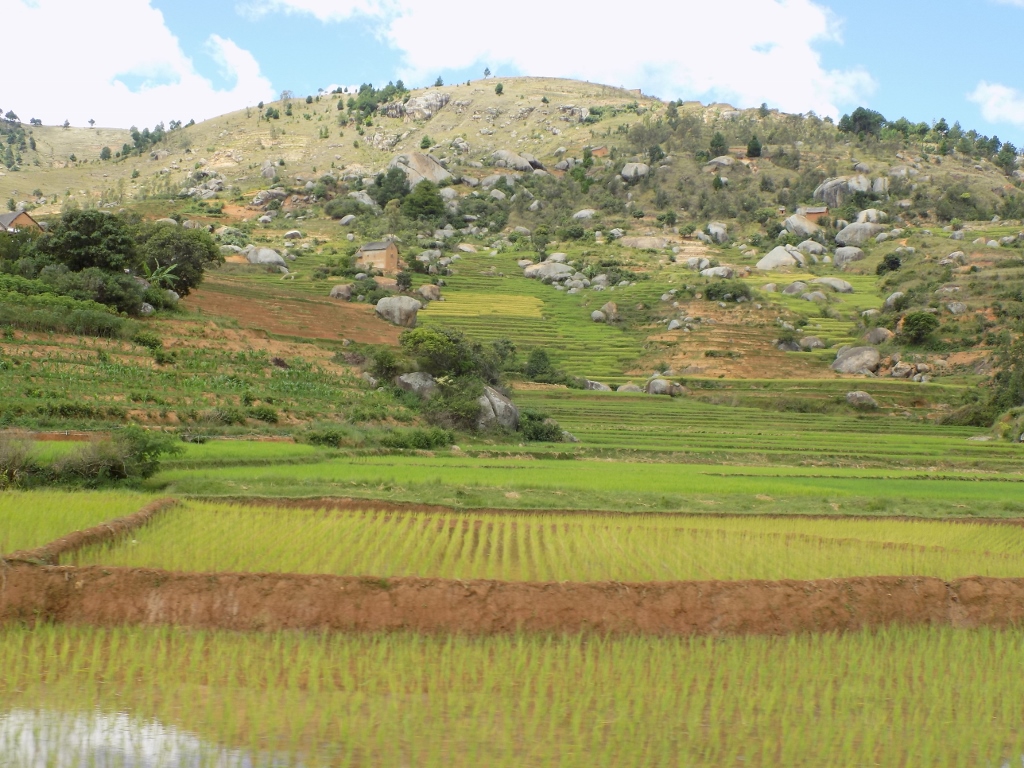 Freshly planted rice in the foreground and older plantations in the background
Freshly planted rice in the foreground and older plantations in the background
Ambositra is a small town which, like Antsirabe, is known for its artisanal workshops, but here the emphasis is put on wood processing and the making of different objects decorated by intarsia. It is also called the “city of roses” having rosewood in mind, since this is the cradle of the Malagasy wood carving art. When we arrived in the town we came across large crowds, since it seemed that it was a market day and thus there were a lot of people and vehicles in the streets. As we were moving relatively slowly, I took the opportunity to film the streets we were going through using my video-camera. I think this makes it easier to get a notion about the appearance of the streets of smaller towns on Madagascar.
There was, of course, a regular photo made from the car.
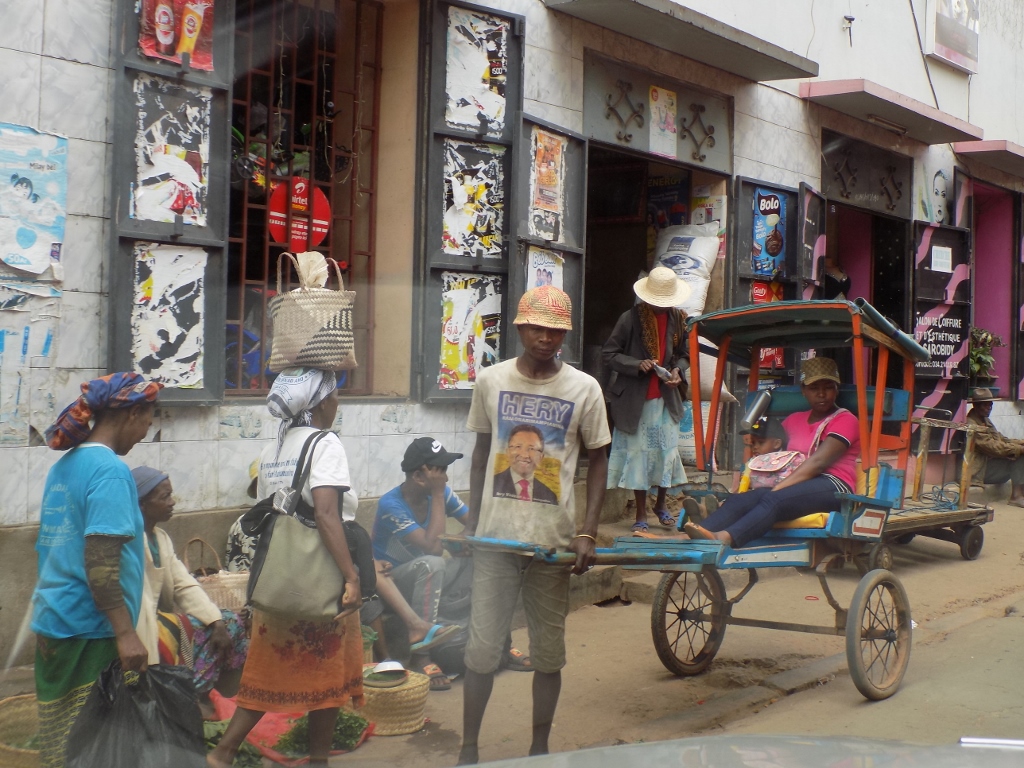 Ambositra street
Ambositra street
In order to visit a workshop for artisanal and artistic wood processing, since there are several of them in the town, the two of us simply let Rija, our driver, organise this. He seemed to know everything and to know exactly where he should take us. From time to time, we also had some special requests of our own, which he readily accepted, but he also gave his own suggestions if he believed that something could be done differently or at some other time. Like in the case of all the people working in tourism throughout the world, it was clear to us that he was taking us to those workshops with which he had some kind of a business deal, but in the end the two of us did not really care where we would go. I believe that the differences, if any, were minimal and we were not necessarily worse off. Thus, we agreed with him to take us first to a Benedictine monastery, since it was around noon and this was the time when the nuns start with their prayers and chanting, so we wanted to take advantage of the favourable circumstances and listen to them for a short while. It was exceptionally pleasant.
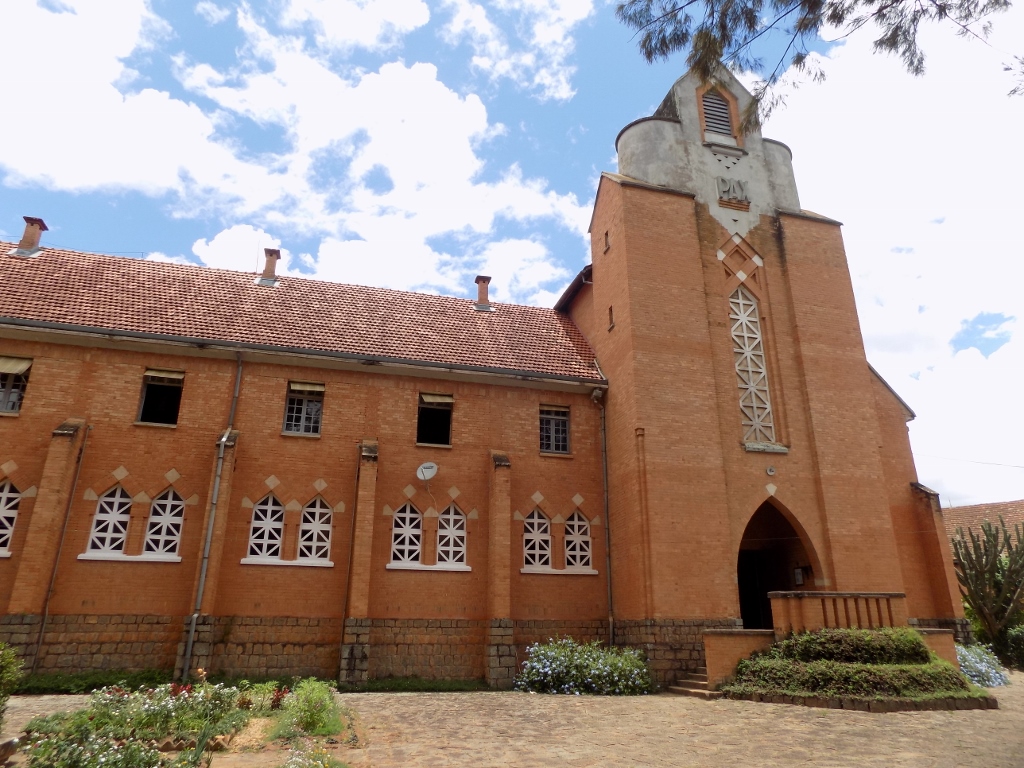 Benedictine monastery in Ambositra
Benedictine monastery in Ambositra
It is good to stop at this monastery also because of the possibility to buy cheese, honey, jams and biscuits made by the nuns, as well as some typical artisanal objects which were significantly cheaper here than in other parts of Madagascar, plus I trust that a part of the income also goes to the maintenance of the monastery and its community.
After this, we could finally go to the workshop with objects made of wood and there were indeed some very nice things there. Both Sneža and I bought a thing or two and then we were ready for lunch.
In order to have lunch, Rija took us to a restaurant that belonged to a hotel and everything on the compound was very nicely and neatly arranged. The temperature was very pleasant, but the clouds were gathering and, while we were sitting on a canopied terrace, there was very light rain. Somehow, this inspired us to try zebu meat. I have nothing special to report – it was beef.
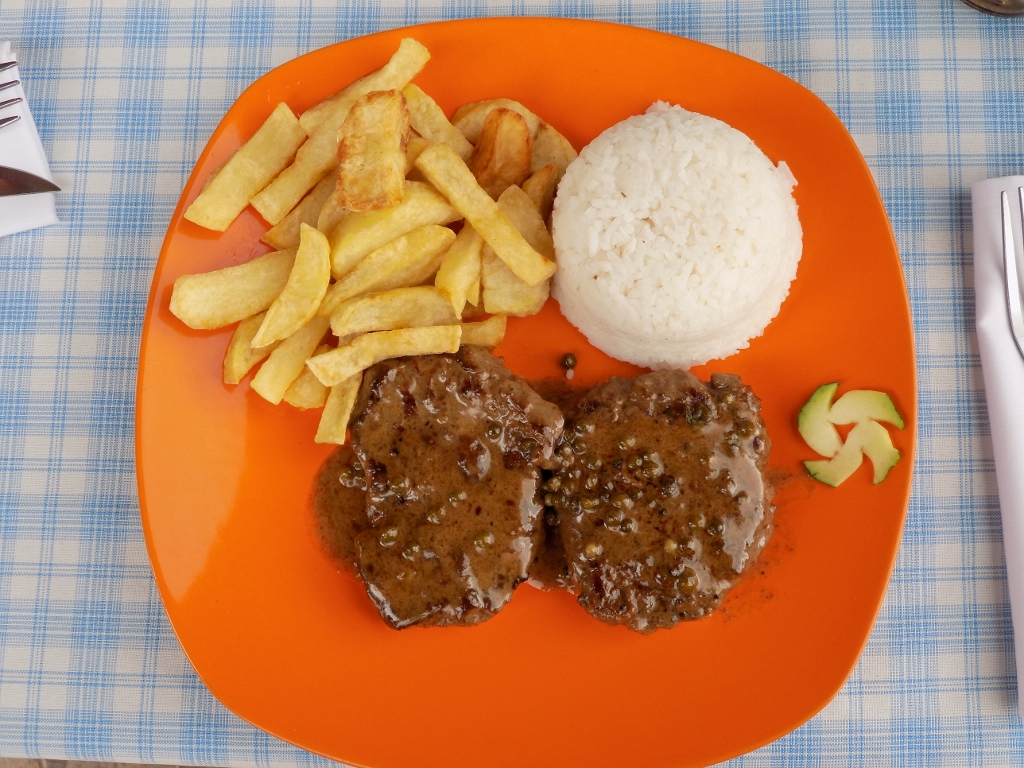 Zebu meat in black pepper sauce
Zebu meat in black pepper sauce
After lunch, we moved on and I realised that my main preoccupation on Madagascar had become the experiencing of utter exaltation while we were travelling by car through this incredibly beautiful country.
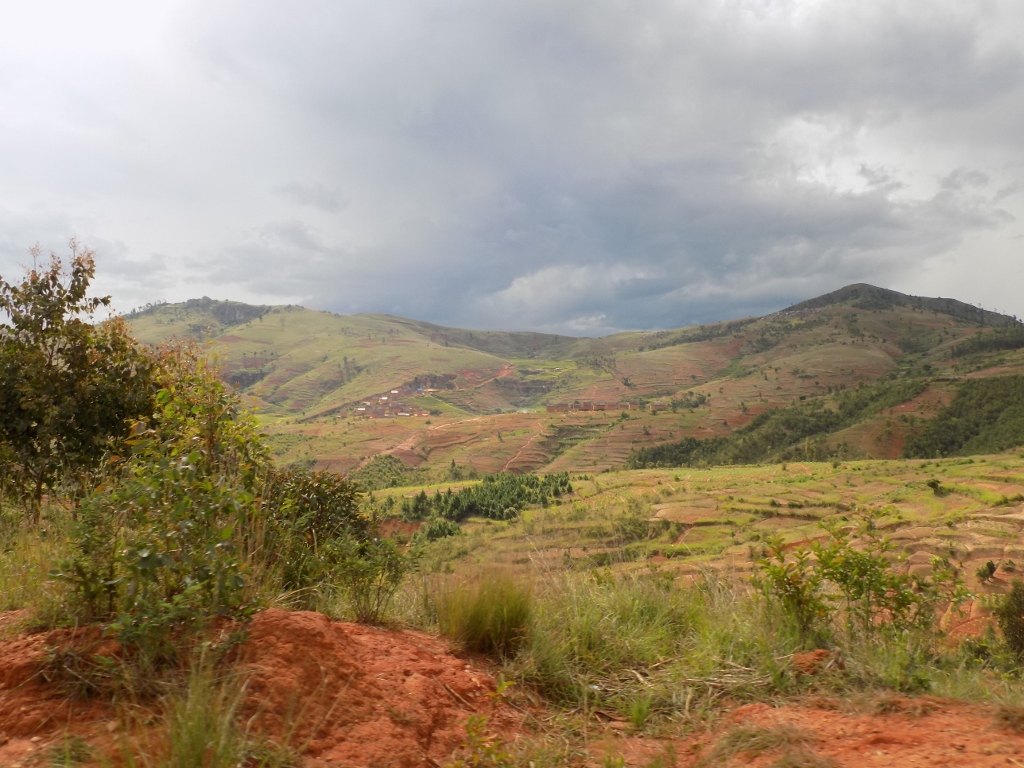 Magnificent landscapes of central Madagascar
Magnificent landscapes of central Madagascar
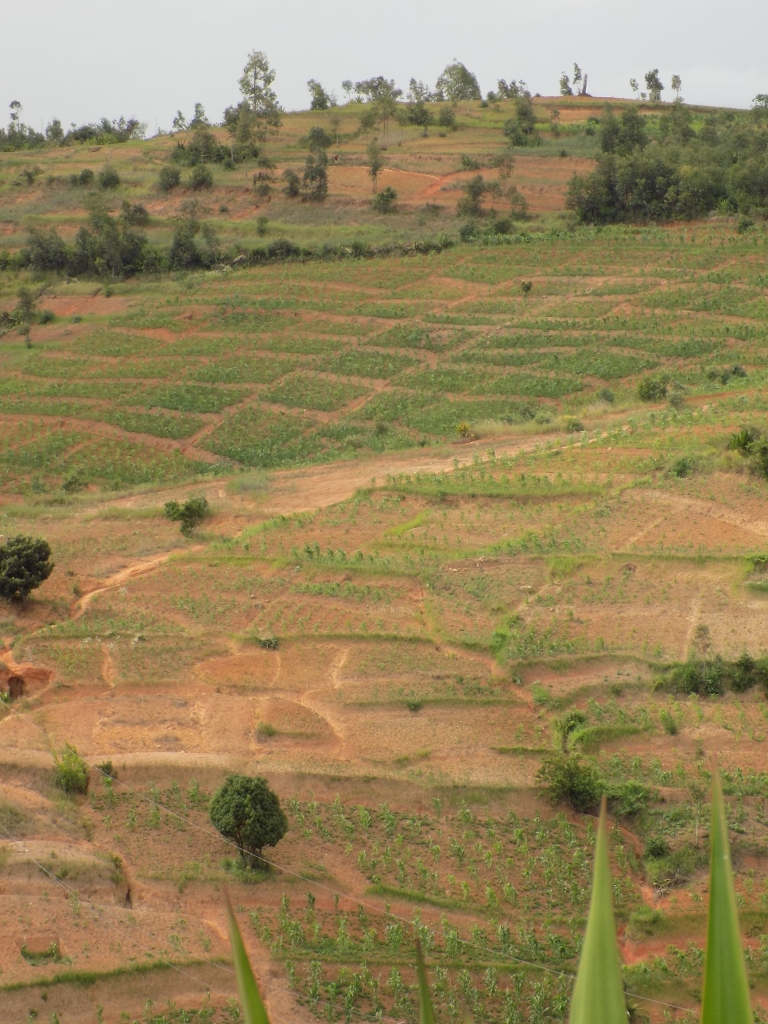 Perfectly arranged crops
Perfectly arranged crops
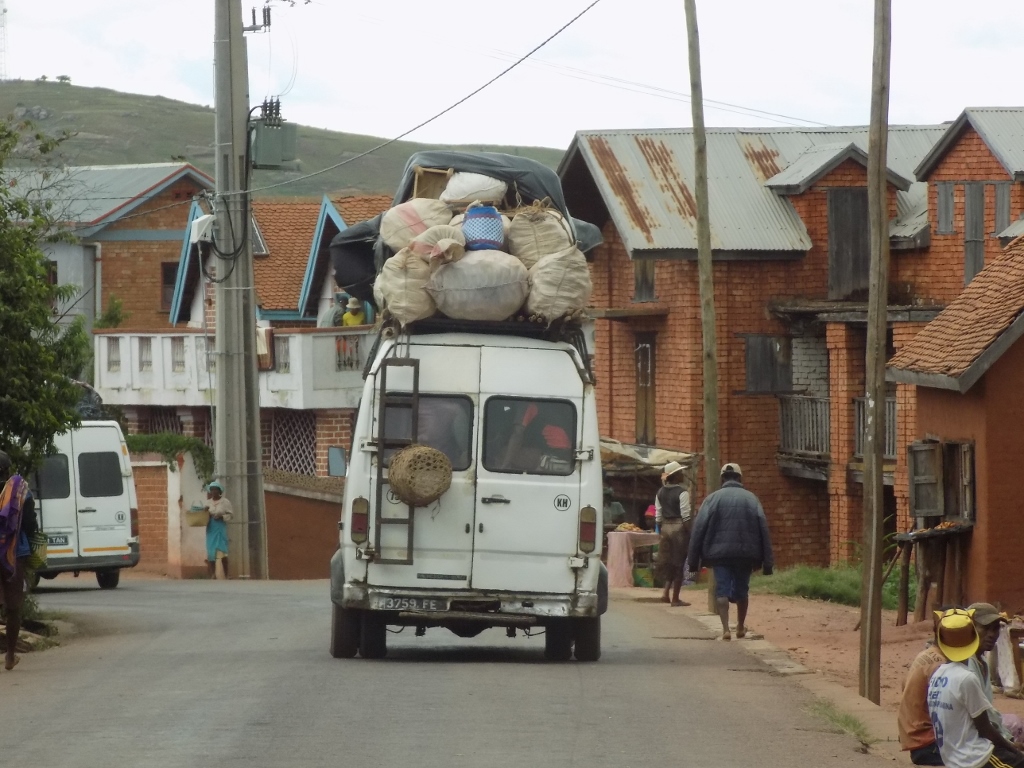 Public inter-city transportation in the shape of taxi-brousse
Public inter-city transportation in the shape of taxi-brousse
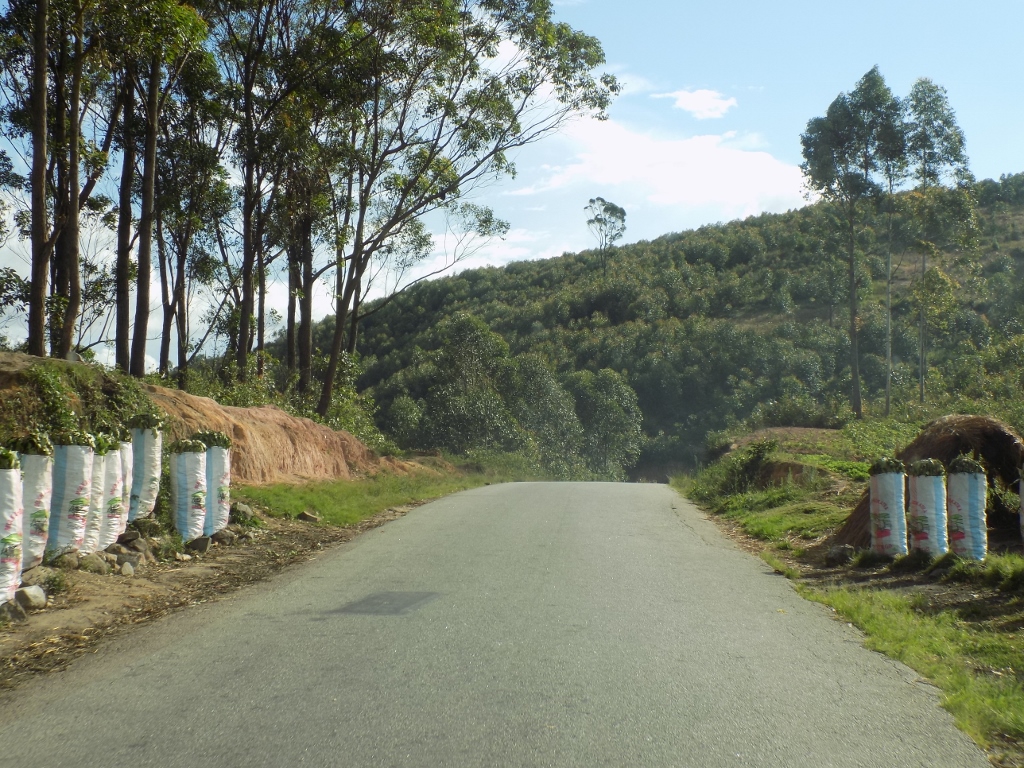 Large bags of charcoal made of the surrounding eucalyptus trees
Large bags of charcoal made of the surrounding eucalyptus trees
I was delighted by everything – the nature, different sights linked to the daily life, people we saw along the way, as well as those rare ones we had some sort of a contact with. This was in fact the only bad side to our type of transportation and “walking” only the typical tourist paths – minimal contacts with the Malagasy who were not linked to tourism and tourists. And yet, I find such contacts very important and every time I had an opportunity I tried to communicate with them in any way I knew, but always with good and heartfelt energy. Thus, even at the airport just before the return flight back to Europe I joked or perhaps even flirted with the policeman at the passport control point, making an agreement with him there and then that the next time I came to Madagascar he would be my personal guide. In those superficial contacts, the seriousness or the depth of the conversation are not important – what is, is the exchange of good, benevolent and positive energy between human beings.
To start with, it was always good to say: “Salama!” meaning “Hello!”
Thus, we stopped at one exceptionally good viewpoint and there between taking photos of the landscapes in front of us, I managed to establish a contact with a woman who worked there breaking some rocks, so I asked her if I could take a photo of her. I truly and absolutely most sincerely think that she was an exceptionally beautiful woman with that charming smile of hers that lit her entire face.
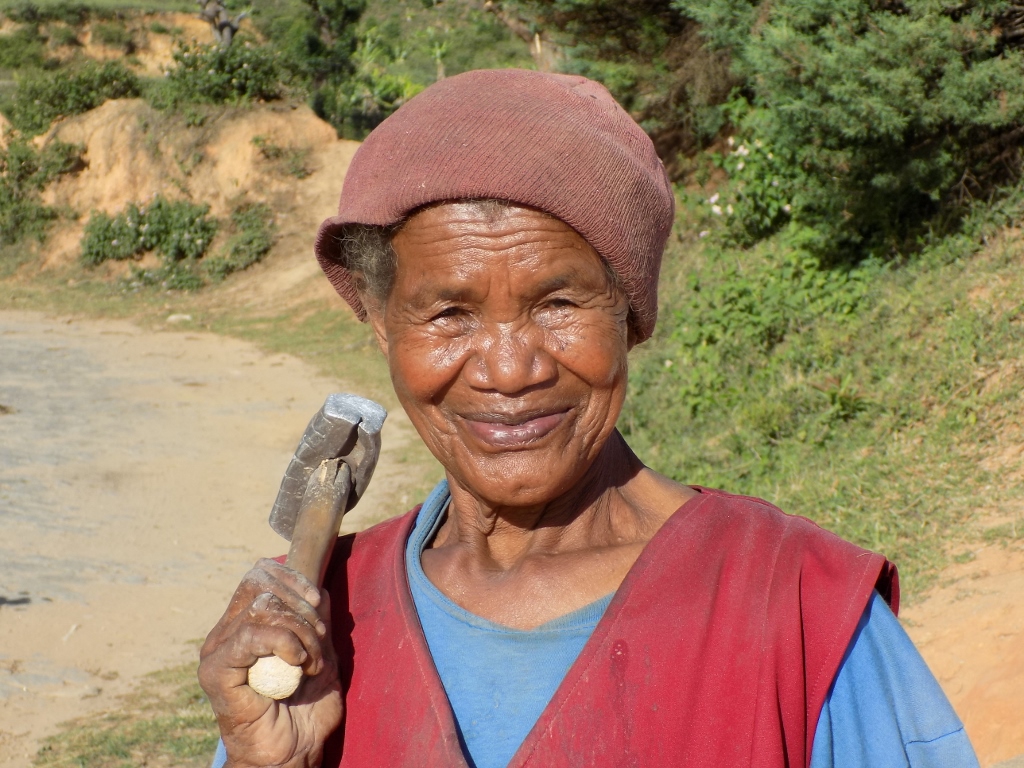 I feel exceptionally honoured that she allowed me to take a photo of her
I feel exceptionally honoured that she allowed me to take a photo of her
But, then again, I found everything in this place utterly stunning and my eyes and soul were relentlessly taking in all that beauty adding images to that feeling of exaltation that was filling me up incessantly.


From that viewpoint, we went down to the flatter areas driving towards town Fianarantsoa. Some of the following photos I made while we were moving, while some I could take standing firmly on the ground since this afternoon Rija was very ready to stop frequently in order for us to be able to take photos, while Sneža could have a cigarette break.
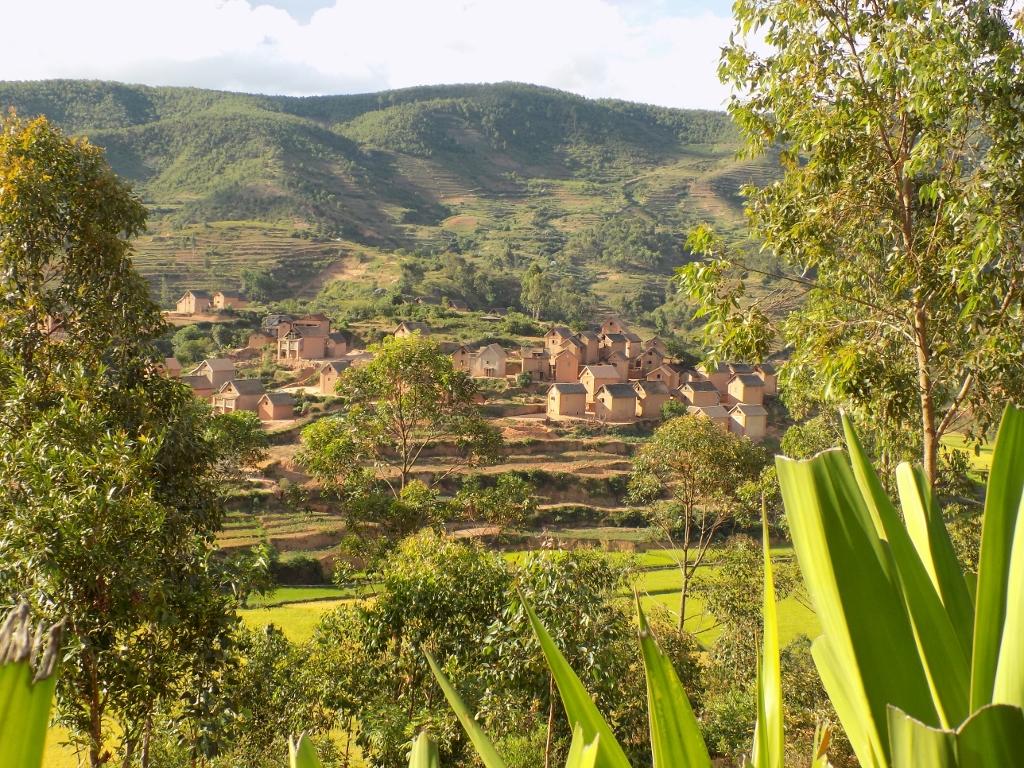 On the road to Fianarantsoa
On the road to Fianarantsoa
As I was standing on an embankment by the road, I noticed a couple of boys not too far from me who thought I was taking photos of them, so they posed. Then I thought it would be a pity not to grant them the wish.
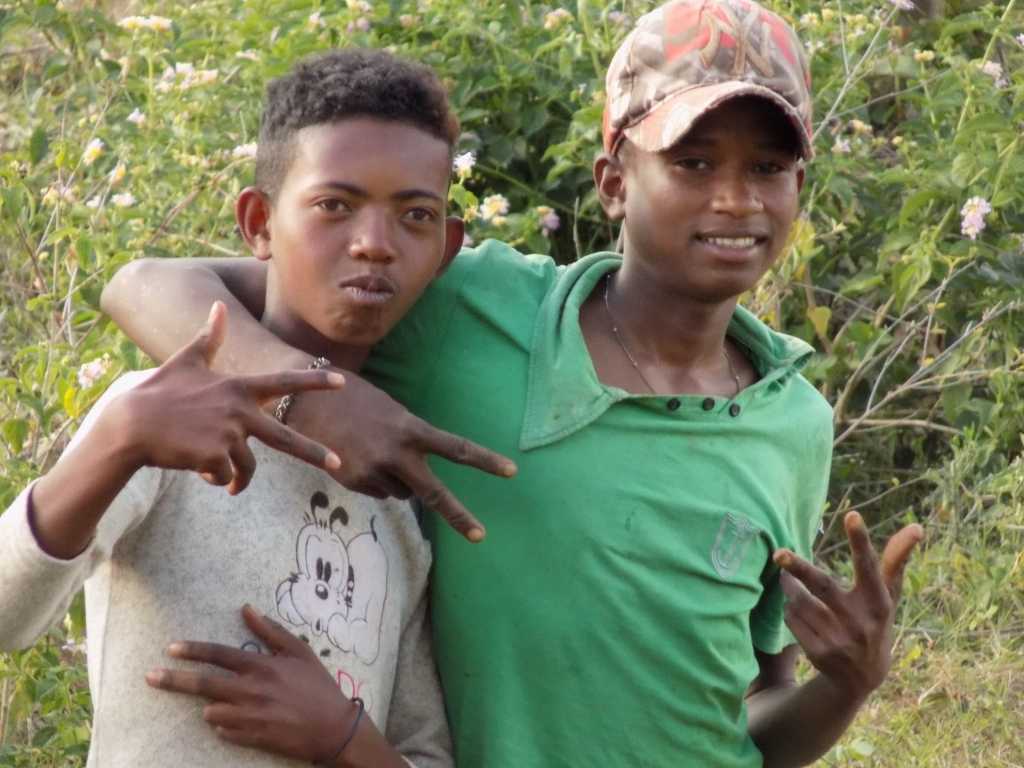 Young generation
Young generation
I also took photos of some people who were not posing for me, but whom I found interesting in some other way, such as one mom who was driving her baby on the motorcycle in front of us.
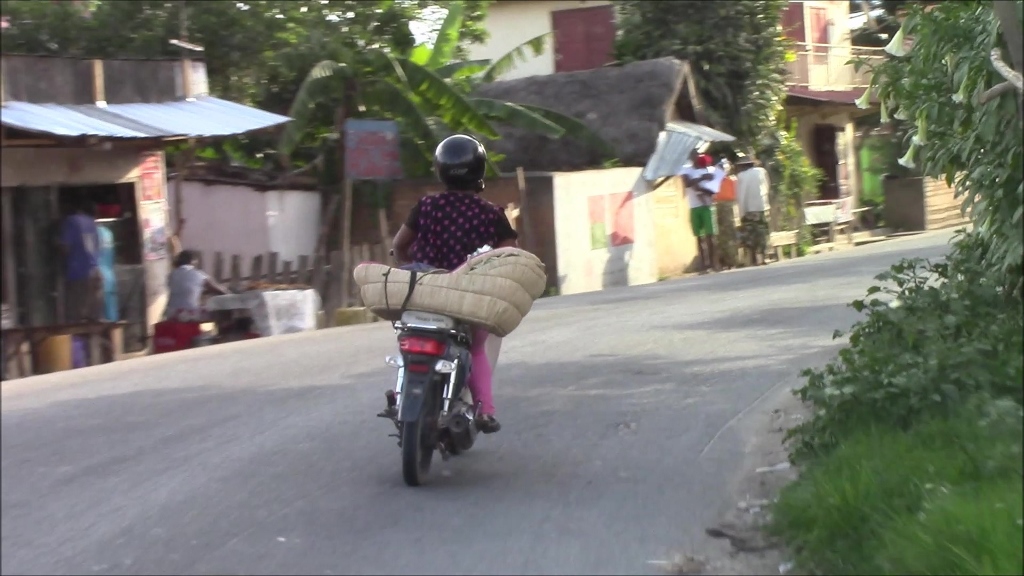 Is the baby fast asleep?
Is the baby fast asleep?
The good thing when it rains sporadically and when there are different clouds in the sky, on top of which it is late afternoon, is that everything seems “washed” by that rain and shines, while the colours are fabulous.
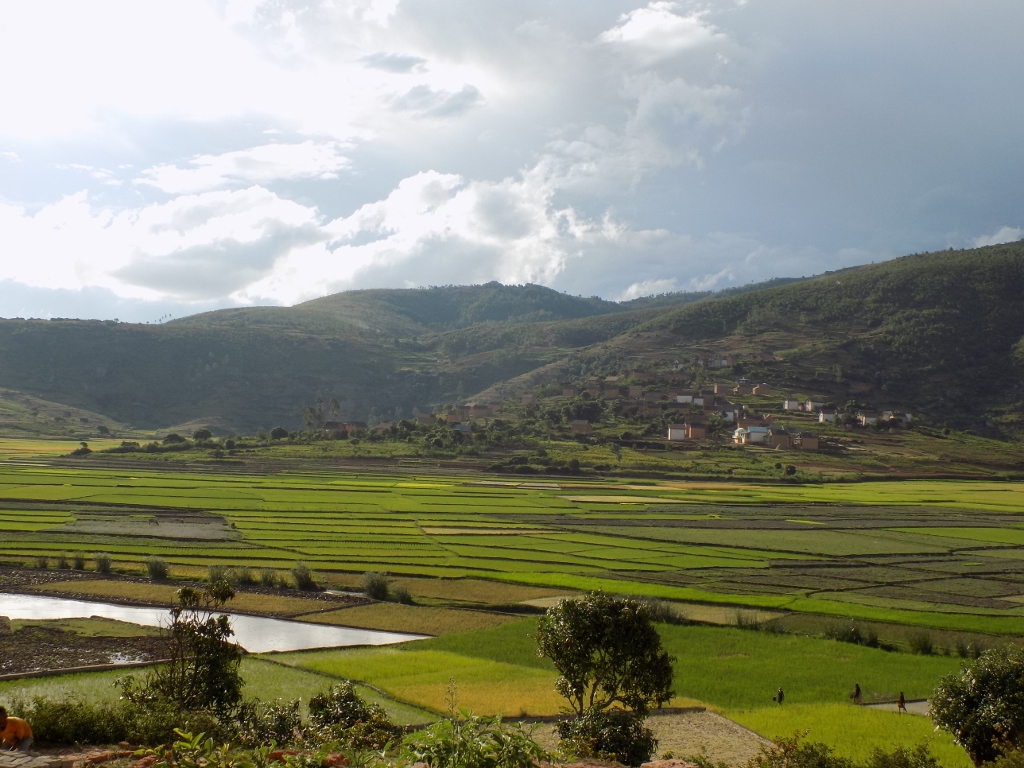 On the road to Fianarantsoa
On the road to Fianarantsoa
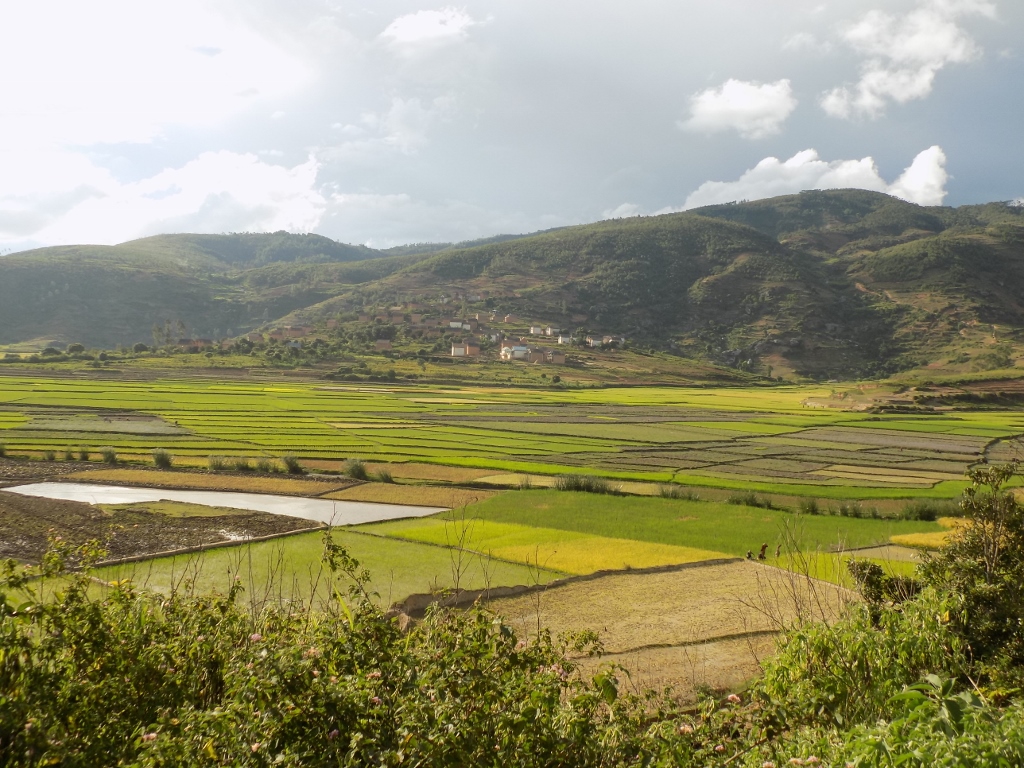 On the road to Fianarantsoa
On the road to Fianarantsoa
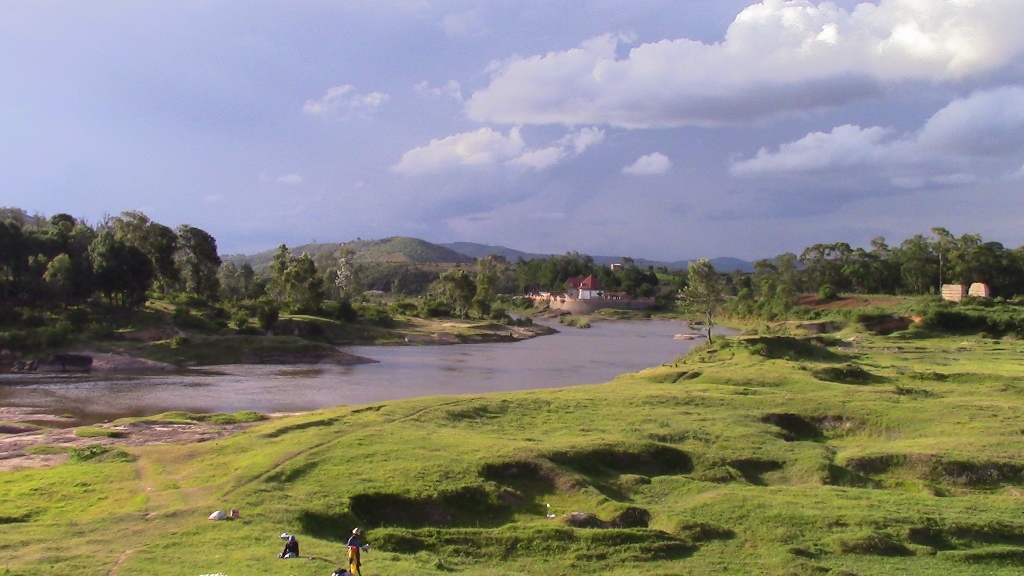 On the road to Fianarantsoa
On the road to Fianarantsoa
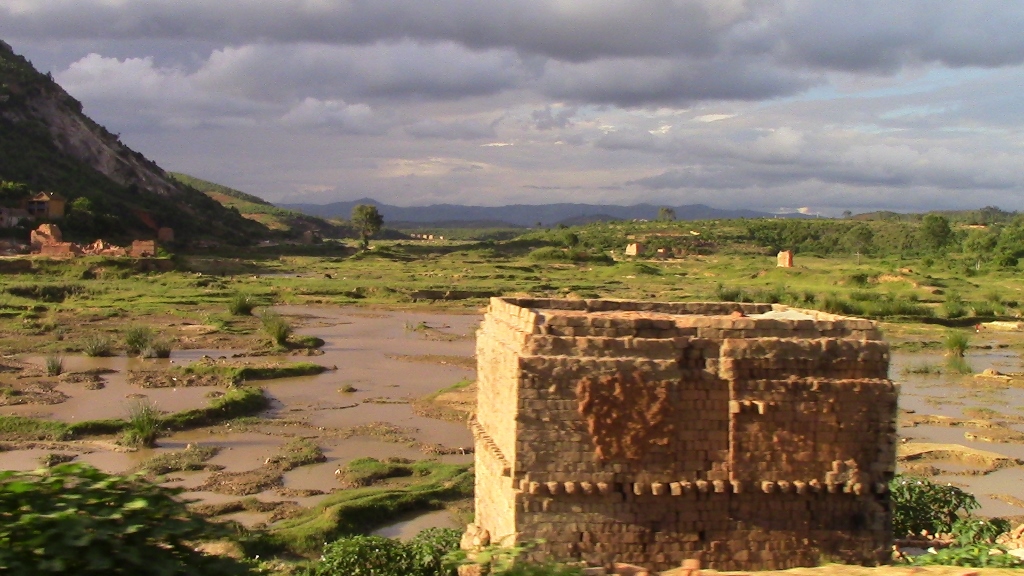 One of the numerous brick kilns on the road to Fianarantsoa which may be seen throughout Madagascar
One of the numerous brick kilns on the road to Fianarantsoa which may be seen throughout Madagascar
Here the road led parallel to the railroad, but we saw no train. Our driver Rija told us that the Malagasy do not use trains much owing to their slowness and that they prefer road transportation. On the other hand, according to what I have read, a ride on Madagascar trains may be considered a proper adventure since there is practically no timetable to speak of and a journey may take anywhere between 12 and 24 hours.
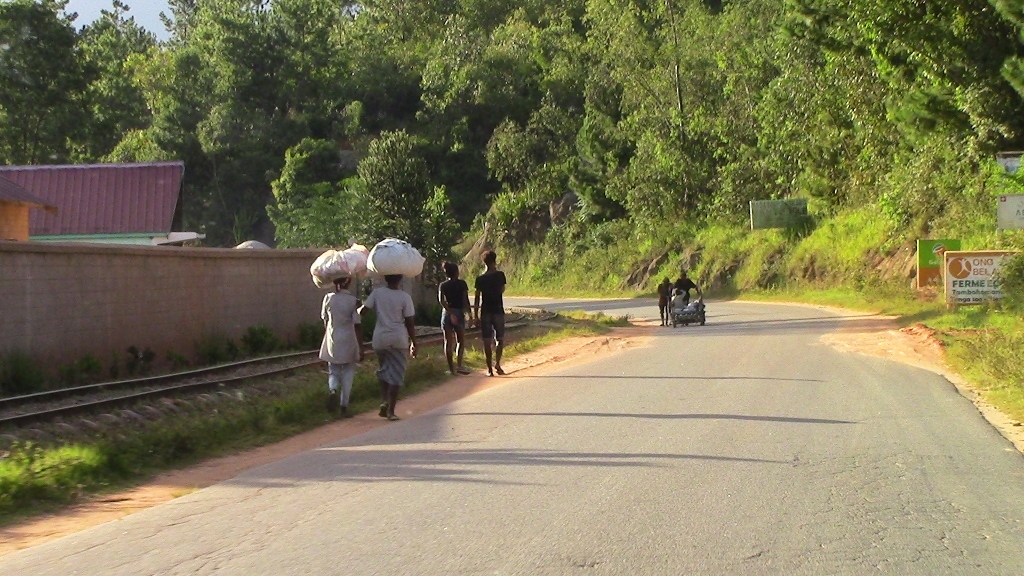 On the road to Fianarantsoa – there is a railroad on the left
On the road to Fianarantsoa – there is a railroad on the left
Having arrived in town Fianarantsoa and after we had left our things in our hotel room, we went out and walked to a nearby restaurant recommended by a girl from the hotel reception. Moreover, this was an incredibly kind girl who left her job post and took us to the main street a couple of hundred metres away in order to show us well where the restaurant was. Generally speaking, the Malagasy are extremely kind and accommodating people, but this girl was still particularly kind.
Once at the restaurant, I did not think for too long as to what I would order and it was again a plate of Mine Sao, a Malagasy dish consisting of noodles, vegetables and meat. My choice regularly involved chicken.
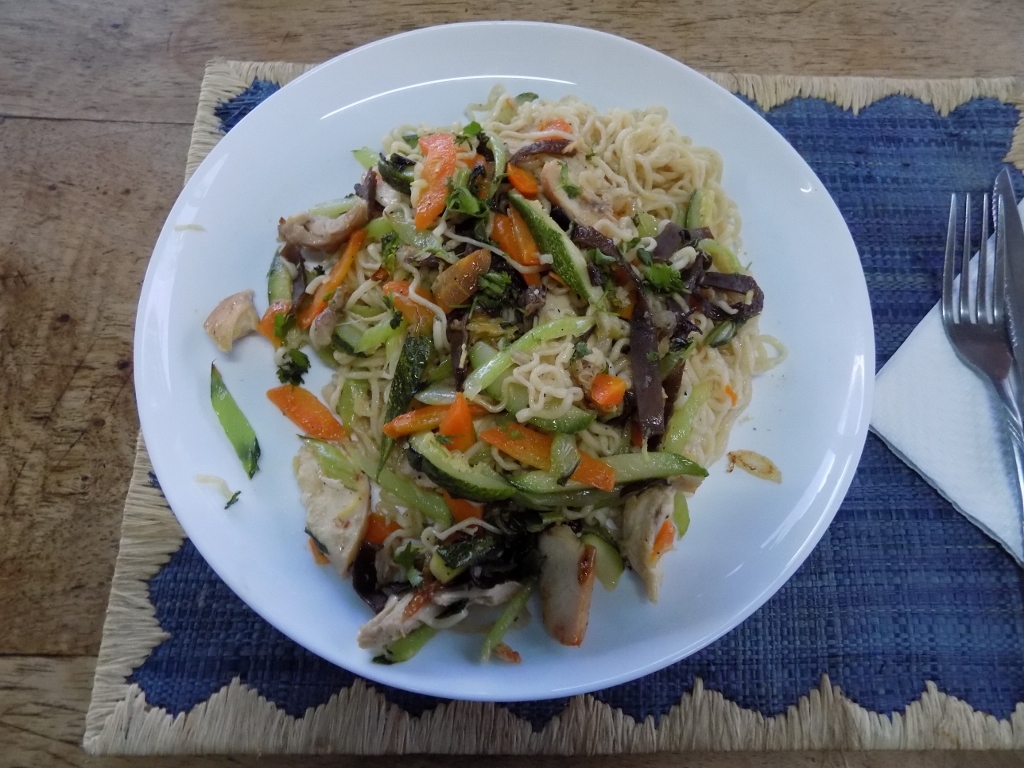 Mine Sao
Mine Sao
On the other hand, it seems fit only now to mention that my almost regular evening drink on Madagascar was local beer, the most popular one – THB, which is an abbreviation of Three Horses Beer.
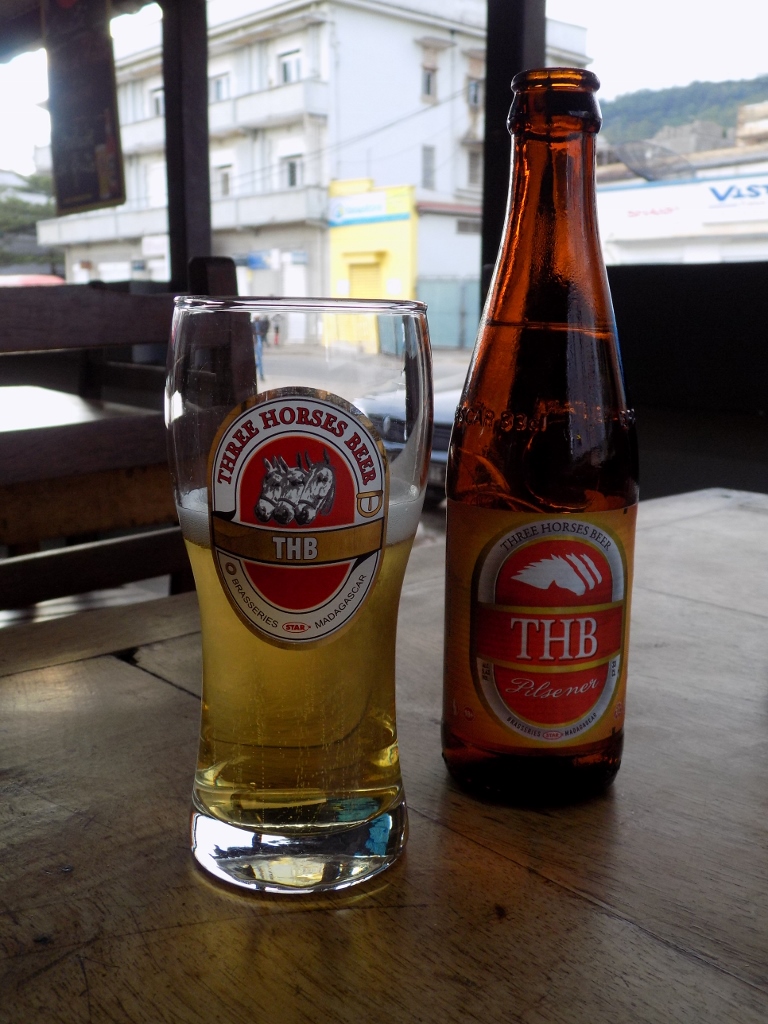 Three Horses Beer
Three Horses Beer